20 bookplates from the John Starr Stewart Ex Libris Collection at the University of Illinois Library
PK at BibliOdyssey featured bookplates from the first half of this database
![]()
Design by A. Dachenhausen, 1900
"Coat of arms: Escutcheon parted per fess, upper part or (gold) charged with an eagle displayed sable (black), lower part paly of six gules (red) and argent (silver), charged with a banner or (gold). Heume surmounted by a deer's head argent, on either side wings paly gules and argent. Mantling. Artist's monogram lower right: AD."
![]()
"Chimpanzee, holding in one foot a caliper, sits on a pile of books contemplating a human skull;. On one book spine: 'Darwin'; on an open book: 'Eritis sicut deus' (You will be as a god)"
![]()
Design by M. H.
"Partly bald man trapped in stocks made of two rows of books supported either side by feather pens."
![]()
Design by K. Rosnyai
"Owl classroom: teacher owl stands beside blackboard with letters and holds open book and pointer, 6 student owls in a line attend."
![]()
"Dock of books and carved waves"
![]()
"World globe with glasses reads an open book, text on cover and spine"
![]()
Design by Aiglon (Attila Sassy), 1911
"Naked woman places chaplet on head of man in robe, who points to a large skull at their feet."
Previous post on this artist
![]()
Design by Marguerite Edwards, 1901
"Snake twines around cup and torches"
![]()
Design by Kraus
"Printed in black on blue paper. Bird's-eye view of Lisbon."
![]()
Design by Harry Townsend
![]()
Design by L. Brunet
"Caricature of Liszt as hand-puppet watches screeching cat claw strings of a guitar"
![]()
Design by Mary Dodd
"Elegantly dressed young girl is driven in a carriage past a line of poor girls."
![]()
Design by Anne M. Danielsen, 1948
"Alice in Wonderland, Little Bo Peep, Snow White and the Seven Dwarfs, the bears, pigs, mice and fish in corners."
![]()
Design by Alfred Petrasch, 1904
"Stylized house, trees and sun."
![]()
Design by Bernard Linnig, 1903
"Dragon on open book, shining sun in background"
![]()
"Stack of books framed by wreath, top book open to picture of steam engine from early railroad."
![]()
Design by Ralph L. Reed, 1902
"Old camera on tripod, crossed rifle and fishing pole, and books against and between two leafy trees with roots."
![]()
Design by H. David
"Man in legal wig reading a manuscript at his desk, behind him a towering skeleton; on a small ledge, a fetus in a glass jar. Books with legible spine labels, incl. "Johnson', 'De motu cordis', 'Theobald's Shakespeare', 'Smollett', 'Akenside', 'Hippocrates', 'Pope's Homer', 'The Works of William Smellie'."
![]()
William Edgar Fisher, 1902
"Snake winding around apple, surmounted by tree with 6 books; above, angels hanging from ribbons; kneeling naked figure looks up at the central design."
![]()
"Masked heart and spinning top."
See all bookplate posts on 50 Watts
See the companion post at BibliOdyssey
![]() "forest sign I," 2010
"forest sign I," 2010
![]() "forest sign II," 2010
"forest sign II," 2010
![]() "forest sign III," 2010
"forest sign III," 2010
![]() "forest sign IV," 2010
"forest sign IV," 2010
![]() "goodbye," 2011 (PSYCHOLOGIE HEUTE magazine)
"goodbye," 2011 (PSYCHOLOGIE HEUTE magazine)
![]() "praying mantis," 2008 (ZWIERCIADŁO magazine)
"praying mantis," 2008 (ZWIERCIADŁO magazine)
![]() "cybersex," 2008 (ZWIERCIADŁO magazine)
"cybersex," 2008 (ZWIERCIADŁO magazine)
![]() "fight I," 2010
"fight I," 2010
![]() "fight II," 2010
See all posts tagged "Poland" on 50 Watts
"fight II," 2010
See all posts tagged "Poland" on 50 Watts
 "forest sign I," 2010
"forest sign I," 2010
 "forest sign II," 2010
"forest sign II," 2010
 "forest sign III," 2010
"forest sign III," 2010
 "forest sign IV," 2010
"forest sign IV," 2010
 "goodbye," 2011 (PSYCHOLOGIE HEUTE magazine)
"goodbye," 2011 (PSYCHOLOGIE HEUTE magazine)
 "praying mantis," 2008 (ZWIERCIADŁO magazine)
"praying mantis," 2008 (ZWIERCIADŁO magazine)
 "cybersex," 2008 (ZWIERCIADŁO magazine)
"cybersex," 2008 (ZWIERCIADŁO magazine)
 "fight I," 2010
"fight I," 2010
 "fight II," 2010
See all posts tagged "Poland" on 50 Watts
"fight II," 2010
See all posts tagged "Poland" on 50 Watts
 Design by A. Dachenhausen, 1900
"Coat of arms: Escutcheon parted per fess, upper part or (gold) charged with an eagle displayed sable (black), lower part paly of six gules (red) and argent (silver), charged with a banner or (gold). Heume surmounted by a deer's head argent, on either side wings paly gules and argent. Mantling. Artist's monogram lower right: AD."
Design by A. Dachenhausen, 1900
"Coat of arms: Escutcheon parted per fess, upper part or (gold) charged with an eagle displayed sable (black), lower part paly of six gules (red) and argent (silver), charged with a banner or (gold). Heume surmounted by a deer's head argent, on either side wings paly gules and argent. Mantling. Artist's monogram lower right: AD."
 "Chimpanzee, holding in one foot a caliper, sits on a pile of books contemplating a human skull;. On one book spine: 'Darwin'; on an open book: 'Eritis sicut deus' (You will be as a god)"
"Chimpanzee, holding in one foot a caliper, sits on a pile of books contemplating a human skull;. On one book spine: 'Darwin'; on an open book: 'Eritis sicut deus' (You will be as a god)"
 Design by M. H.
"Partly bald man trapped in stocks made of two rows of books supported either side by feather pens."
Design by M. H.
"Partly bald man trapped in stocks made of two rows of books supported either side by feather pens."
 Design by K. Rosnyai
"Owl classroom: teacher owl stands beside blackboard with letters and holds open book and pointer, 6 student owls in a line attend."
Design by K. Rosnyai
"Owl classroom: teacher owl stands beside blackboard with letters and holds open book and pointer, 6 student owls in a line attend."
 "Dock of books and carved waves"
"Dock of books and carved waves"
 "World globe with glasses reads an open book, text on cover and spine"
"World globe with glasses reads an open book, text on cover and spine"
 Design by Aiglon (Attila Sassy), 1911
"Naked woman places chaplet on head of man in robe, who points to a large skull at their feet."
Previous post on this artist
Design by Aiglon (Attila Sassy), 1911
"Naked woman places chaplet on head of man in robe, who points to a large skull at their feet."
Previous post on this artist
 Design by Marguerite Edwards, 1901
"Snake twines around cup and torches"
Design by Marguerite Edwards, 1901
"Snake twines around cup and torches"
 Design by Kraus
"Printed in black on blue paper. Bird's-eye view of Lisbon."
Design by Kraus
"Printed in black on blue paper. Bird's-eye view of Lisbon."
 Design by Harry Townsend
Design by Harry Townsend
 Design by L. Brunet
"Caricature of Liszt as hand-puppet watches screeching cat claw strings of a guitar"
Design by L. Brunet
"Caricature of Liszt as hand-puppet watches screeching cat claw strings of a guitar"
 Design by Mary Dodd
"Elegantly dressed young girl is driven in a carriage past a line of poor girls."
Design by Mary Dodd
"Elegantly dressed young girl is driven in a carriage past a line of poor girls."
 Design by Anne M. Danielsen, 1948
"Alice in Wonderland, Little Bo Peep, Snow White and the Seven Dwarfs, the bears, pigs, mice and fish in corners."
Design by Anne M. Danielsen, 1948
"Alice in Wonderland, Little Bo Peep, Snow White and the Seven Dwarfs, the bears, pigs, mice and fish in corners."
 Design by Alfred Petrasch, 1904
"Stylized house, trees and sun."
Design by Alfred Petrasch, 1904
"Stylized house, trees and sun."
 Design by Bernard Linnig, 1903
"Dragon on open book, shining sun in background"
Design by Bernard Linnig, 1903
"Dragon on open book, shining sun in background"
 "Stack of books framed by wreath, top book open to picture of steam engine from early railroad."
"Stack of books framed by wreath, top book open to picture of steam engine from early railroad."
 Design by Ralph L. Reed, 1902
"Old camera on tripod, crossed rifle and fishing pole, and books against and between two leafy trees with roots."
Design by Ralph L. Reed, 1902
"Old camera on tripod, crossed rifle and fishing pole, and books against and between two leafy trees with roots."
 Design by H. David
"Man in legal wig reading a manuscript at his desk, behind him a towering skeleton; on a small ledge, a fetus in a glass jar. Books with legible spine labels, incl. "Johnson', 'De motu cordis', 'Theobald's Shakespeare', 'Smollett', 'Akenside', 'Hippocrates', 'Pope's Homer', 'The Works of William Smellie'."
Design by H. David
"Man in legal wig reading a manuscript at his desk, behind him a towering skeleton; on a small ledge, a fetus in a glass jar. Books with legible spine labels, incl. "Johnson', 'De motu cordis', 'Theobald's Shakespeare', 'Smollett', 'Akenside', 'Hippocrates', 'Pope's Homer', 'The Works of William Smellie'."
 William Edgar Fisher, 1902
"Snake winding around apple, surmounted by tree with 6 books; above, angels hanging from ribbons; kneeling naked figure looks up at the central design."
William Edgar Fisher, 1902
"Snake winding around apple, surmounted by tree with 6 books; above, angels hanging from ribbons; kneeling naked figure looks up at the central design."
 "Masked heart and spinning top."
See all bookplate posts on 50 Watts
See the companion post at BibliOdyssey
"Masked heart and spinning top."
See all bookplate posts on 50 Watts
See the companion post at BibliOdyssey
 Bio from the Kodomo No Kuni site:Takei was born in Suwa, Nagano prefecture in 1894. After studying at the Hongo Yoga Kenkyujo (Hongo Research Institute for Western Art) he entered the Western-style art department of Tokyo Art School in 1919. He was an ardent admirer of illustrator Takehisa Yumeji and poet Kitahara Hakushu. After graduation from art school, he married in 1921 and to support his new family he began to produce illustrations for children for Kodomo no tomo [Child's Friend], a children's magazine published by Fujin no Tomo Sha. In 1922 he became one of the leading illustrators for Kodomo no kuni [Children's Land] from its inaugural issue. In 1923 he published Otogi no tamago [The Fairy's Egg], and in 1925 his first individual exhibition was held in Ginza in the heart of Tokyo. His Ramu-ramu O [King Ramu-ramu] came out in 1926. The following year, with Shimizu Yoshio, Okamoto Kiichi, Kawakami Shiro, and other illustrators contributing to the Kodomo no kuni, Takei formed the Nihon Doga Kyokai (Japan Association of Illustration for Children), as part of the effort to achieve artistic quality in illustrations for children. Following Okamoto's death, Takei succeeded him as critic and selector of illustrations submitted to Kodomo no kuni in 1931. In 1955, he became editorial adviser for the magazine Kinda bukku [Kinder Book].
I again found these images in the database of the National Diet Library. My only disappointment is that there are no dogs with eyes as big as mill-wheels.
The post title of course comes from Andersen.
Some of Takei's books have been reprinted and are available from amazon.co.jp.
Previous posts on this artist
Bio from the Kodomo No Kuni site:Takei was born in Suwa, Nagano prefecture in 1894. After studying at the Hongo Yoga Kenkyujo (Hongo Research Institute for Western Art) he entered the Western-style art department of Tokyo Art School in 1919. He was an ardent admirer of illustrator Takehisa Yumeji and poet Kitahara Hakushu. After graduation from art school, he married in 1921 and to support his new family he began to produce illustrations for children for Kodomo no tomo [Child's Friend], a children's magazine published by Fujin no Tomo Sha. In 1922 he became one of the leading illustrators for Kodomo no kuni [Children's Land] from its inaugural issue. In 1923 he published Otogi no tamago [The Fairy's Egg], and in 1925 his first individual exhibition was held in Ginza in the heart of Tokyo. His Ramu-ramu O [King Ramu-ramu] came out in 1926. The following year, with Shimizu Yoshio, Okamoto Kiichi, Kawakami Shiro, and other illustrators contributing to the Kodomo no kuni, Takei formed the Nihon Doga Kyokai (Japan Association of Illustration for Children), as part of the effort to achieve artistic quality in illustrations for children. Following Okamoto's death, Takei succeeded him as critic and selector of illustrations submitted to Kodomo no kuni in 1931. In 1955, he became editorial adviser for the magazine Kinda bukku [Kinder Book].
I again found these images in the database of the National Diet Library. My only disappointment is that there are no dogs with eyes as big as mill-wheels.
The post title of course comes from Andersen.
Some of Takei's books have been reprinted and are available from amazon.co.jp.
Previous posts on this artist











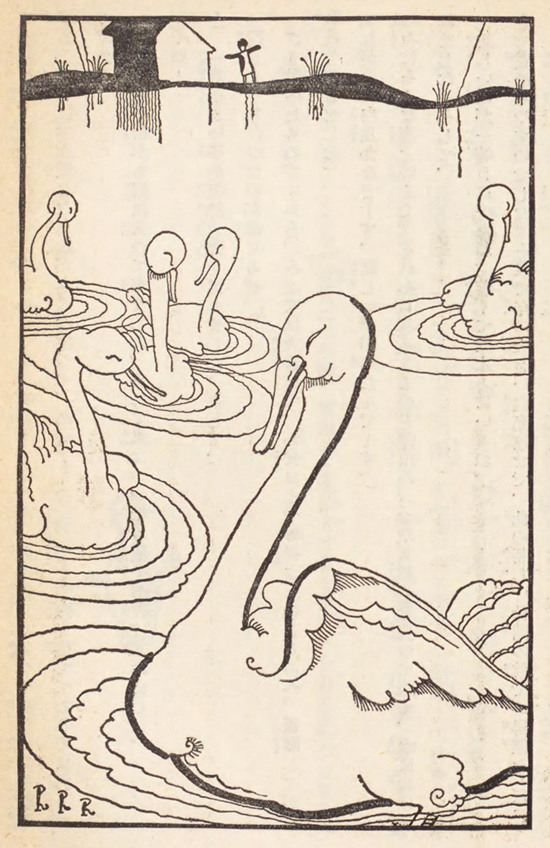








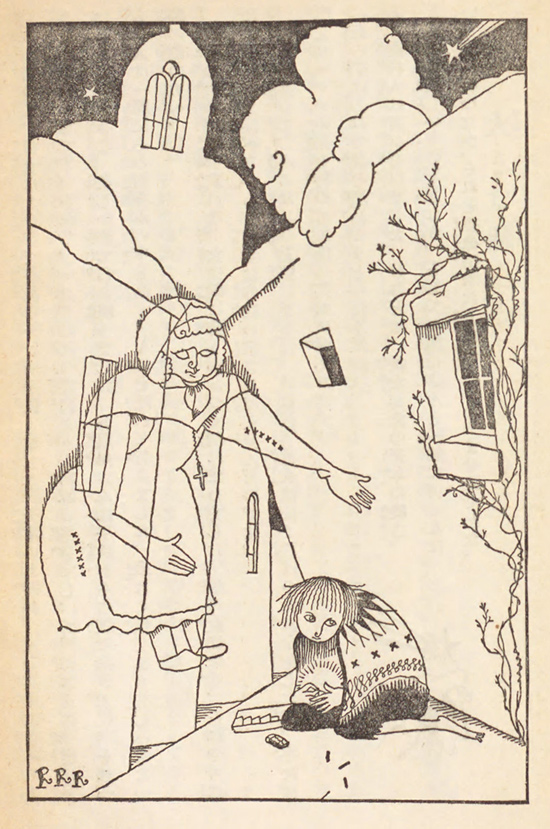







 cover
Previous posts on this artist
cover
Previous posts on this artist
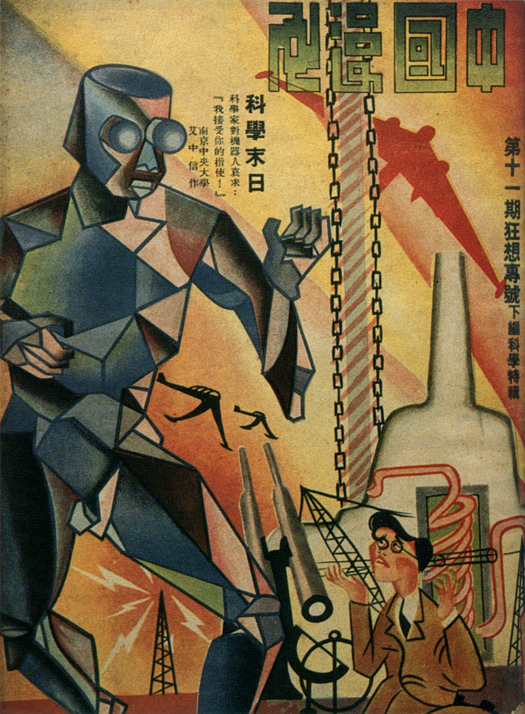 China Sketch, December 1936
"The End of Science" (back cover)
Illustrator: Zhong-xin
China Sketch, December 1936
"The End of Science" (back cover)
Illustrator: Zhong-xin
 China Sketch, December 1936
Designer: Tian Wu-zai
China Sketch, December 1936
Designer: Tian Wu-zai
 Ten Years of the Shenshi Telegraphic Dispatch Agency, c. 1930
Designer: Qian Jun-tao
Ten Years of the Shenshi Telegraphic Dispatch Agency, c. 1930
Designer: Qian Jun-tao
 The Short Story Magazine, August 1927.
Designer: Chen Zhi-fo
The Short Story Magazine, August 1927.
Designer: Chen Zhi-fo
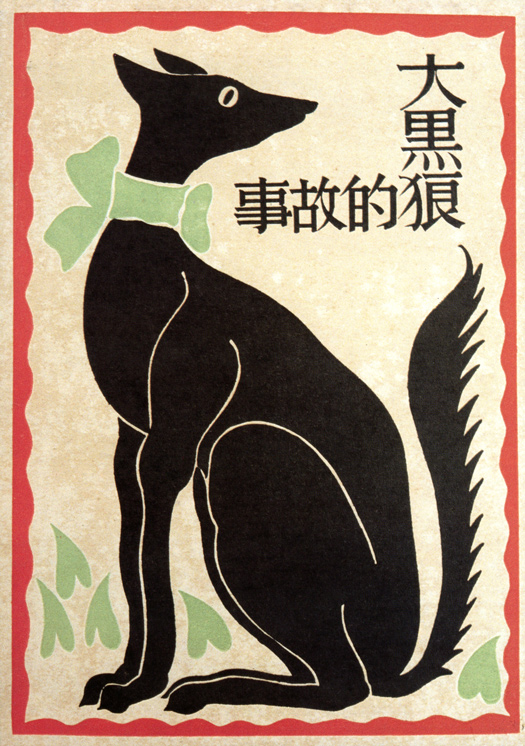 The Big Black Wolf, 1930
Designer: Qian Jun-tao
The Big Black Wolf, 1930
Designer: Qian Jun-tao
 A Great Love, 1930
Designer: Qian Jun-tao
A Great Love, 1930
Designer: Qian Jun-tao
 Modern Student, June 1931
Designer: Chen Zhi-fo
Modern Student, June 1931
Designer: Chen Zhi-fo
 Book cover, 1936
Designer: Zheng Ren-ze
Book cover, 1936
Designer: Zheng Ren-ze
 Children's Music, c. 1930
Designer: Qian Jun-tao
Children's Music, c. 1930
Designer: Qian Jun-tao
 Art Deco-style ad, c. 1930s
Art Deco-style ad, c. 1930s
 Creation Monthly, 1928
Creation Monthly, 1928
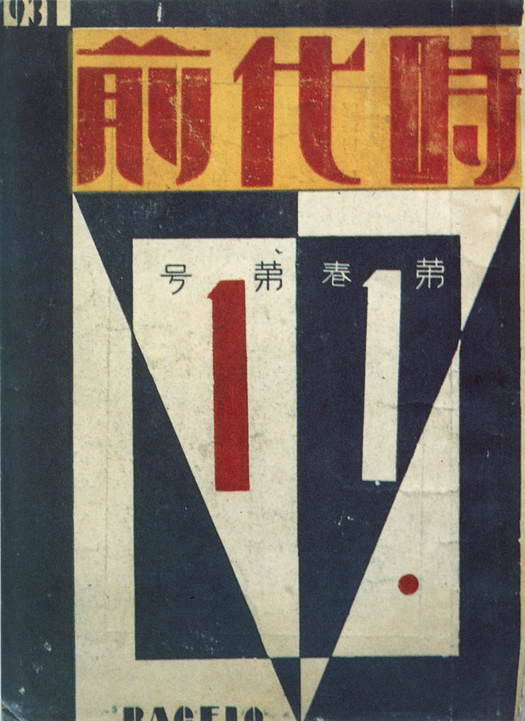 Ahead of the Times, January 1931
Designer: Qian Jun-tao
Ahead of the Times, January 1931
Designer: Qian Jun-tao
 Science and Engineering Magazine, 1935
Designer: Hong Qing
Science and Engineering Magazine, 1935
Designer: Hong Qing
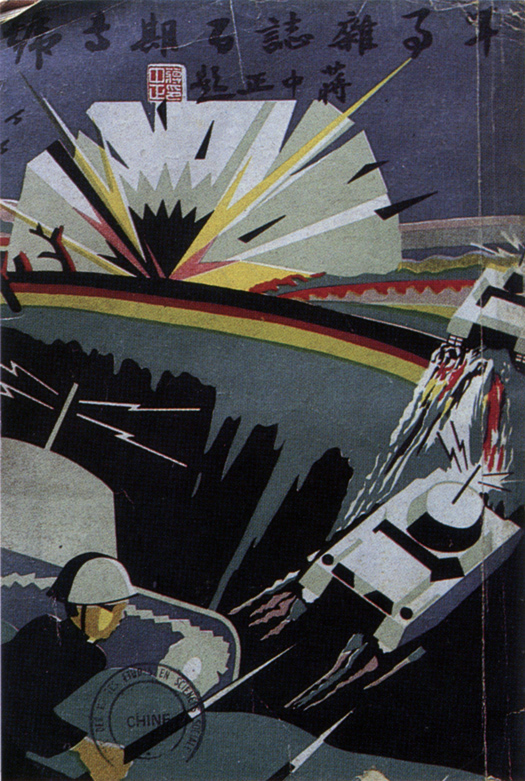 Military Magazine, April 1937
Military Magazine, April 1937
 China Sketch, April 1936
"Madame Sanger in China" (Sanger was an American proponent of birth control)
Illustrator: Zhu Jin-lou
China Sketch, April 1936
"Madame Sanger in China" (Sanger was an American proponent of birth control)
Illustrator: Zhu Jin-lou
 The Dividing Line in Love, 1929.
Designer: Qian Jun-tao
The Dividing Line in Love, 1929.
Designer: Qian Jun-tao
 The Ladies' Journal, October 1931
Designer: Zhang Ling-tao
The Ladies' Journal, October 1931
Designer: Zhang Ling-tao
 Wandering, August 1929
Designer: Tao Yuan-qing
Wandering, August 1929
Designer: Tao Yuan-qing
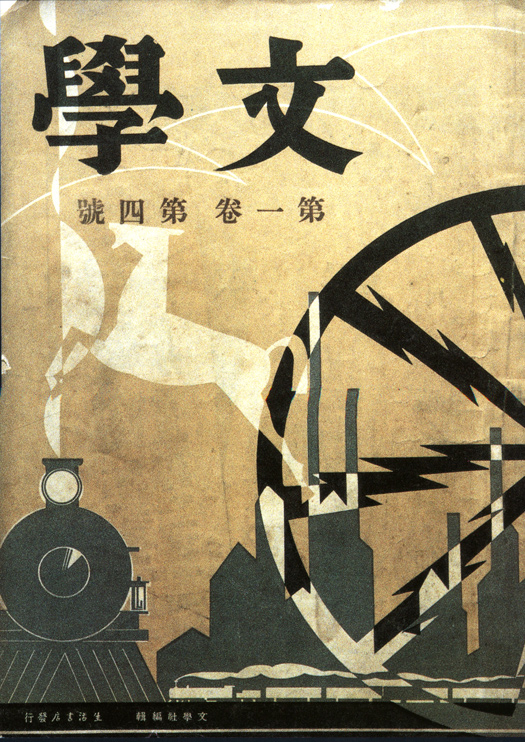 Literature, October 1933
Designer: Chen Zhi-fo
Literature, October 1933
Designer: Chen Zhi-fo
 Literature Weekly, undated issue on Russian short stories
Designer: Qian Jun-tao
Literature Weekly, undated issue on Russian short stories
Designer: Qian Jun-tao
 The Ark, February 1935
The Ark, February 1935
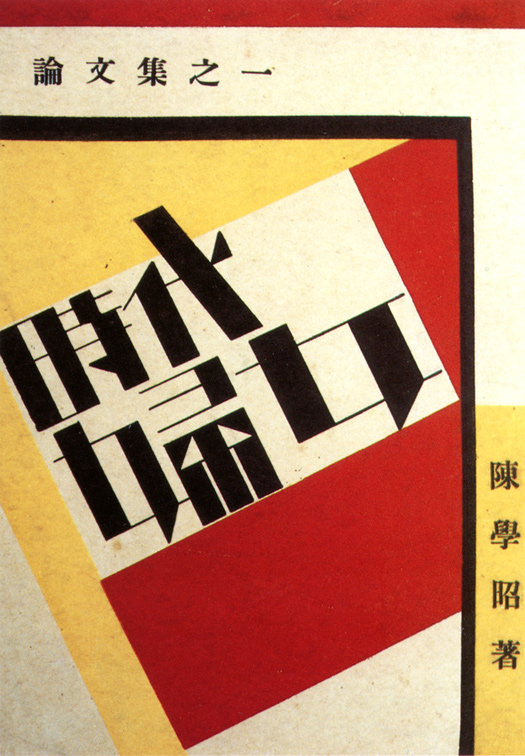 Modern Woman, 1933
Designer: Qian Jun-tao
Modern Woman, 1933
Designer: Qian Jun-tao
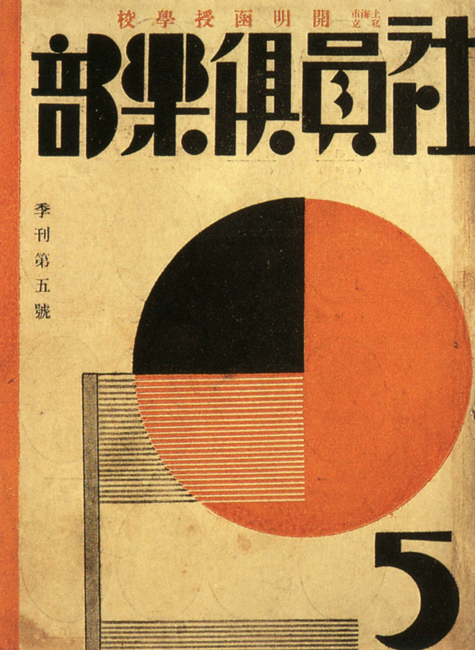 Shanghai Private Kaiming Correspondence School,
Members' Club Quarterly, c. 1930
Designer: Qian Jun-tao
Shanghai Private Kaiming Correspondence School,
Members' Club Quarterly, c. 1930
Designer: Qian Jun-tao
 The Muddy Stream, 1931
Designer: Qian Jun-tao
The Muddy Stream, 1931
Designer: Qian Jun-tao
 New literature advertisement, c. 1937
Designer: Zhang Xue-fu
For a few more political works see the complementary post on A Journey Round My Skull: Santa Claus delivers a new child into a world of violence and death
Publisher's description:From posters and advertisements to book covers and magazines, this book presents a dazzling panoply of modern graphic design in China.
Beginning with the basic traditions of Chinese graphics, the authors show how the writer and artist Lu Xun became the center of cultural revival in the new China. We see Art Deco coming to China in the Shanghai Style, and the birth of a dynamic national design style, born of Russian Constructivism and China’s own drive for new technology. The Socialist Realist art of Mao in turn adopted folk art traditions to fuel the Revolutionary machine, while the continuing search for a new identity can be seen in the graphic images of protest from the summer of 1989. 150 color and 135 black-and-white photographs and illustrations.
Chinese Graphic Design in the Twentieth Century makes a nice companion to the Steven Heller's Art Deco Graphic Design series for Chronicle (though it's published by Thames & Hudson).
Previously: Extraordinary early twentieth century book and magazine covers from Japan
Tweet this
New literature advertisement, c. 1937
Designer: Zhang Xue-fu
For a few more political works see the complementary post on A Journey Round My Skull: Santa Claus delivers a new child into a world of violence and death
Publisher's description:From posters and advertisements to book covers and magazines, this book presents a dazzling panoply of modern graphic design in China.
Beginning with the basic traditions of Chinese graphics, the authors show how the writer and artist Lu Xun became the center of cultural revival in the new China. We see Art Deco coming to China in the Shanghai Style, and the birth of a dynamic national design style, born of Russian Constructivism and China’s own drive for new technology. The Socialist Realist art of Mao in turn adopted folk art traditions to fuel the Revolutionary machine, while the continuing search for a new identity can be seen in the graphic images of protest from the summer of 1989. 150 color and 135 black-and-white photographs and illustrations.
Chinese Graphic Design in the Twentieth Century makes a nice companion to the Steven Heller's Art Deco Graphic Design series for Chronicle (though it's published by Thames & Hudson).
Previously: Extraordinary early twentieth century book and magazine covers from Japan
Tweet this
 "I was always disappointed with my finished art. It was never as good as I hoped it would be. At age seven, I was already judging myself by impossibly high standards; my mother, too, judged me by adult standards. In fact, I still have the Junior Art Gallery clay sculpture; when I look at it now, I can see that it was quite accomplished for a seven year old. Now, in my early sixties, making art has been a big part of my life for years, as much of a saving grace for me as reading was when I was six. When I draw, my muse speaks to me."
"I was always disappointed with my finished art. It was never as good as I hoped it would be. At age seven, I was already judging myself by impossibly high standards; my mother, too, judged me by adult standards. In fact, I still have the Junior Art Gallery clay sculpture; when I look at it now, I can see that it was quite accomplished for a seven year old. Now, in my early sixties, making art has been a big part of my life for years, as much of a saving grace for me as reading was when I was six. When I draw, my muse speaks to me."


 "The stallions I drew were copies of one on the covers of one of the first horse stories I read, The Black Stallion, but the stories I imagined about them were different. I had listened to the cowboy stories on the radio with my grandfather after dinner. I especially liked 'Straight Arrow' and 'The Lone Ranger' because both heroes had hidden identities. In bed at night, I lay in the dark and imagined that I had a stallion like the one in my drawings, a wild stallion, wild to every one but me. He was mine, and when I whistled my secret whistle, he thundered to my side in a flash. I whistled for him to save me from bad guys or to help me save good guys from bad ones. Then I galloped away on my stallion, leaving every one dazed and wondering who that brave little girl was."
"The stallions I drew were copies of one on the covers of one of the first horse stories I read, The Black Stallion, but the stories I imagined about them were different. I had listened to the cowboy stories on the radio with my grandfather after dinner. I especially liked 'Straight Arrow' and 'The Lone Ranger' because both heroes had hidden identities. In bed at night, I lay in the dark and imagined that I had a stallion like the one in my drawings, a wild stallion, wild to every one but me. He was mine, and when I whistled my secret whistle, he thundered to my side in a flash. I whistled for him to save me from bad guys or to help me save good guys from bad ones. Then I galloped away on my stallion, leaving every one dazed and wondering who that brave little girl was."

 "At home I drew horses in pencil on the blank pages in the front and back of my books. In Miss Brooks's class we worked on art projects twice a week. I made clay finger puppets of all the puppet characters on my favorite TV show, 'Kukla, Fran and Ollie.' Kukla was a cheery little bald guy with a round nose, dots for eyes and a high, squeaky voice; Ollie, my favorite, was a friendly but naughty dragon with only one big pointy tooth just under his pointy snout at the front of his huge mouth. I didn't care much for Fran, who was a human being, sweet but boring. There was also a snooty old woman puppet, Madame Oglepuss, who acted very glamorous, but with her huge curved nose and baggy eyes, was really ugly. When I wrote the cursive 'J' of my name at the top of my school papers, I always made it as a profile of Madame Oglepuss."
"At home I drew horses in pencil on the blank pages in the front and back of my books. In Miss Brooks's class we worked on art projects twice a week. I made clay finger puppets of all the puppet characters on my favorite TV show, 'Kukla, Fran and Ollie.' Kukla was a cheery little bald guy with a round nose, dots for eyes and a high, squeaky voice; Ollie, my favorite, was a friendly but naughty dragon with only one big pointy tooth just under his pointy snout at the front of his huge mouth. I didn't care much for Fran, who was a human being, sweet but boring. There was also a snooty old woman puppet, Madame Oglepuss, who acted very glamorous, but with her huge curved nose and baggy eyes, was really ugly. When I wrote the cursive 'J' of my name at the top of my school papers, I always made it as a profile of Madame Oglepuss."



 "The collage of the baby enjoying the frolicking alligator is me and it came to me in a very positive dream about fifteen years ago. The setting was the backyard of the house I have lived in for 38 years. In the dream the alligators were playful, filled with energy and not at all frightening. I did not come to terms with my father's death until I was in my fifties, after a dream in which I was able to look into my father's coffin and see that he looked just as he had looked in life--and then I cried for him for the first time."
Press release (edition of 500 copies):Joanne Oldham has quietly been making art in a range of mediums for several decades. Though mostly known for a scattering of Bonnie ‘Prince’ Billy releases, including the iconic cover for I See a Darkness, the vast majority of this prolific artist and writer’s work has never been seen outside of her circle of family and friends. Intensely personal, warm, and often terrifying, her art is playful and mysterious, existing in a space of constant conflict. The debut issue of Good Morning dedicates the entire issue to a selection of work done over the last 25 years showcasing Oldham’s unique vision. Collages, paintings, drawings, as well as excerpts from Oldham’s memoir of growing up in the south in the 1950s are included, as well as biographical notes written by the artist herself.
"The collage of the baby enjoying the frolicking alligator is me and it came to me in a very positive dream about fifteen years ago. The setting was the backyard of the house I have lived in for 38 years. In the dream the alligators were playful, filled with energy and not at all frightening. I did not come to terms with my father's death until I was in my fifties, after a dream in which I was able to look into my father's coffin and see that he looked just as he had looked in life--and then I cried for him for the first time."
Press release (edition of 500 copies):Joanne Oldham has quietly been making art in a range of mediums for several decades. Though mostly known for a scattering of Bonnie ‘Prince’ Billy releases, including the iconic cover for I See a Darkness, the vast majority of this prolific artist and writer’s work has never been seen outside of her circle of family and friends. Intensely personal, warm, and often terrifying, her art is playful and mysterious, existing in a space of constant conflict. The debut issue of Good Morning dedicates the entire issue to a selection of work done over the last 25 years showcasing Oldham’s unique vision. Collages, paintings, drawings, as well as excerpts from Oldham’s memoir of growing up in the south in the 1950s are included, as well as biographical notes written by the artist herself.
 front cover
front cover










 back cover
Estonian art and illustration on 50 Watts
back cover
Estonian art and illustration on 50 Watts
 Ruldolf Kalvach, postcard 29
Ruldolf Kalvach, postcard 29
 Hans Kalmsteiner, postcard 305
Hans Kalmsteiner, postcard 305
 Ludwig Heinrich Jungnickel, postcard 380
Ludwig Heinrich Jungnickel, postcard 380
 Ludwig Heinrich Jungnickel, postcard 381
Ludwig Heinrich Jungnickel, postcard 381
 Fritz Zeymer, postcard 151
Fritz Zeymer, postcard 151
 Mela Koehler, postcard 556
Mela Koehler, postcard 556
 Moriz Jung, postcard 96
Moriz Jung, postcard 96
 Moriz Jung, postcard 82
Moriz Jung, postcard 82
 Berthold Loffler, postcard 71
Berthold Loffler, postcard 71
 Rudolf Kalvach, postcard 148
Rudolf Kalvach, postcard 148
 Rudolf Kalvach, postcard 100
Rudolf Kalvach, postcard 100
 Oskar Kokoschka, postcard 78
Oskar Kokoschka, postcard 78
 Carl Otto Czeschka, postcard 252
Carl Otto Czeschka, postcard 252
 Josef Diveky, postcard 501
Josef Diveky, postcard 501
 Unknown, signed LZ, postcard 576
Unknown, signed LZ, postcard 576
 Maria Likarz, postcard 748
Maria Likarz, postcard 748
 Mela Koehler, postcard 477
Mela Koehler, postcard 477
 Moriz Jung, postcard 532
Moriz Jung, postcard 532
 Moriz Jung, postcard 87
Moriz Jung, postcard 87
 Urban Janke, Til Eulenspiegel, postcard 18
Previously: Kolo's Kinderbuch
Urban Janke, Til Eulenspiegel, postcard 18
Previously: Kolo's Kinderbuch
 Sadao Sato, late 80s
(this image extends an inch beyond my scanner on all four sides)
Sadao Sato, late 80s
(this image extends an inch beyond my scanner on all four sides)
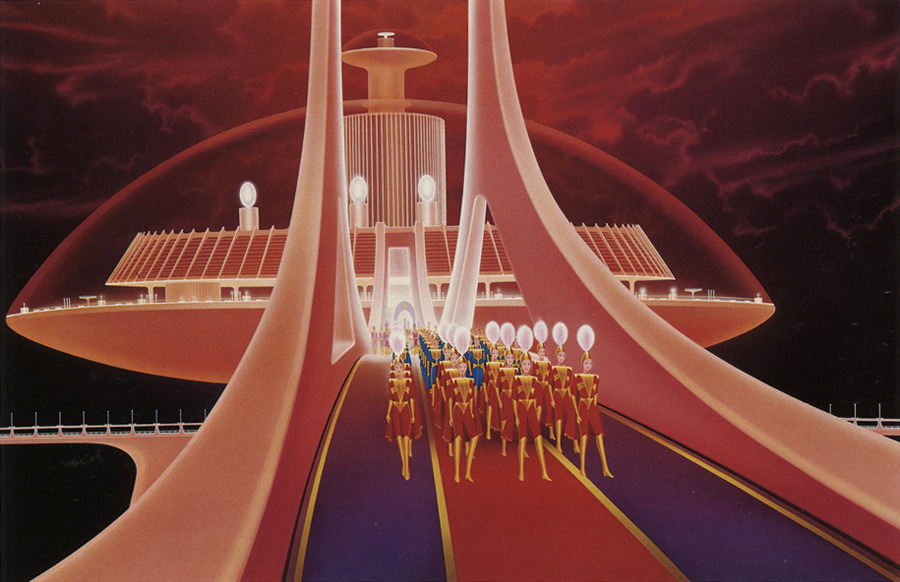 Shusei Nagaoka, from Androla in Labyrinth, 1984
Shusei Nagaoka, from Androla in Labyrinth, 1984
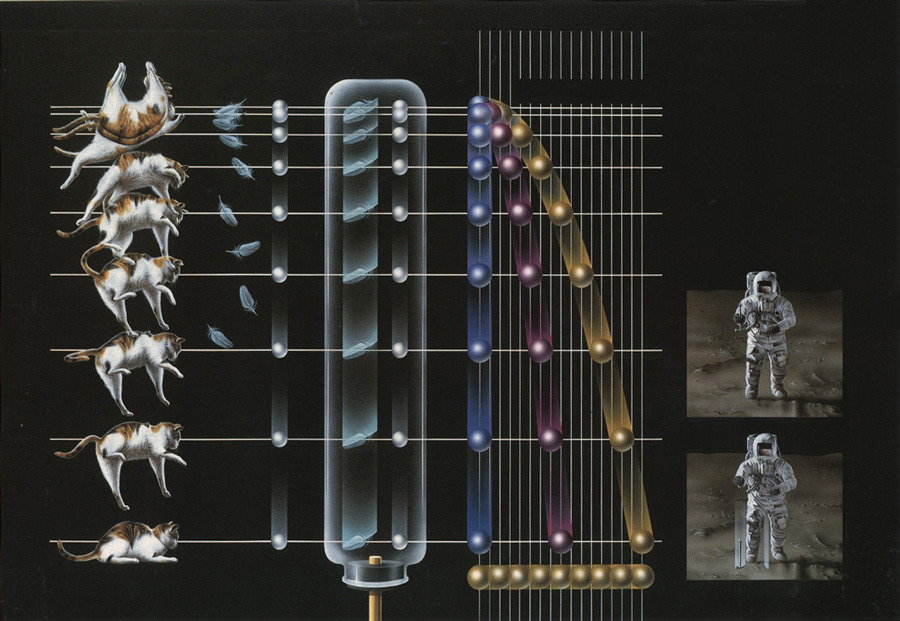 "Falling motion," illustration by Kazuho Itoh for "Newton," mid-80s
"Falling motion," illustration by Kazuho Itoh for "Newton," mid-80s
 Kazuo Haba, early 70s
Kazuo Haba, early 70s
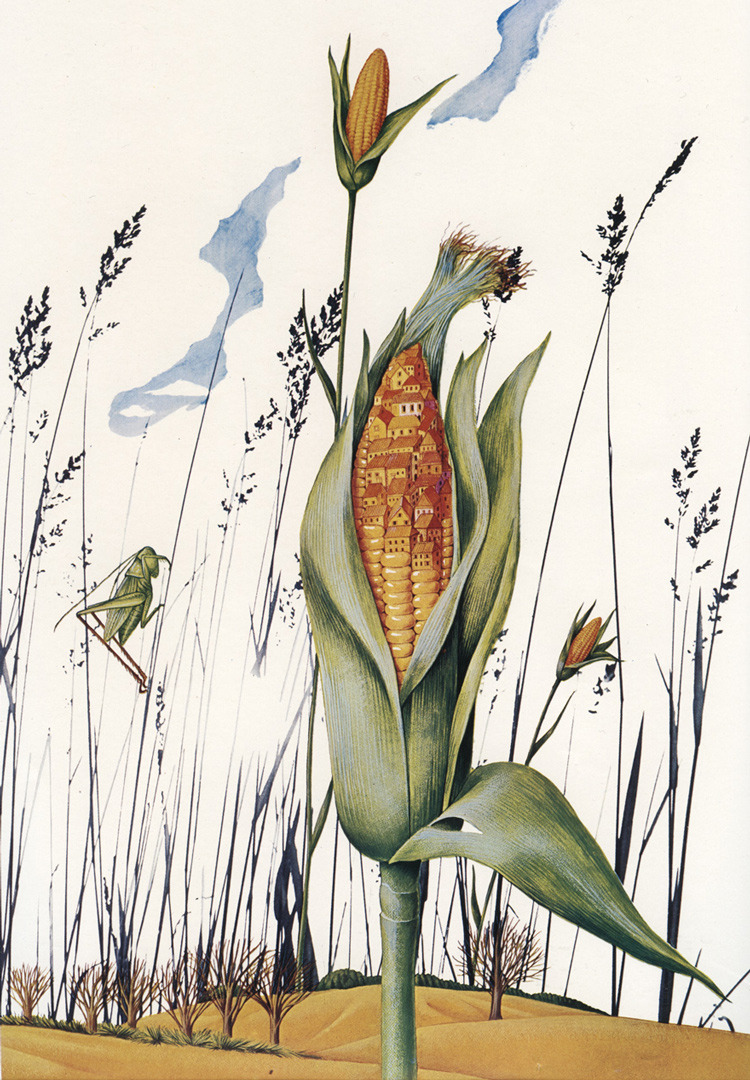 Sonoko Arai, early 70s
Sonoko Arai, early 70s
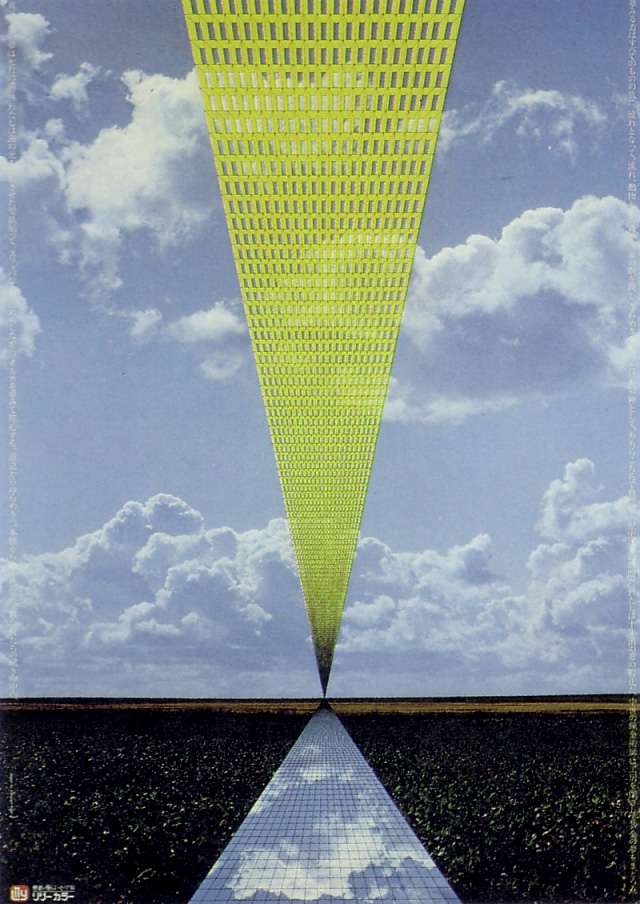 Kazumasa Nagai, poster
Kazumasa Nagai, poster
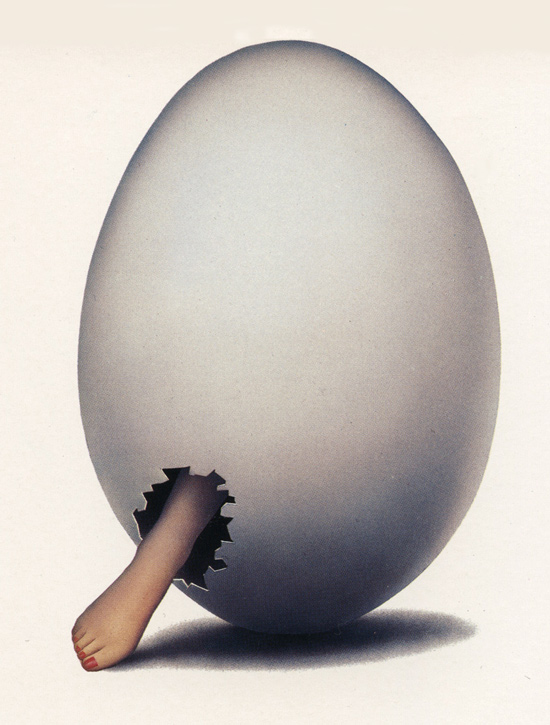 Masao Minami, early 70s
Masao Minami, early 70s
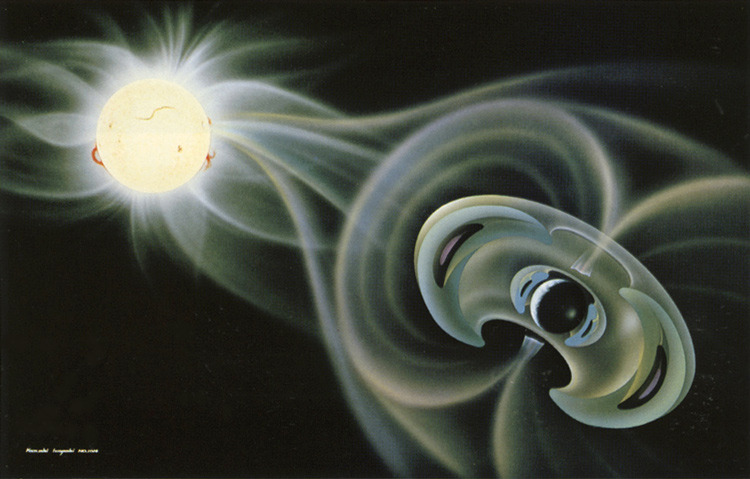 Kazuaki Iwasaki, mid-80s
Kazuaki Iwasaki, mid-80s
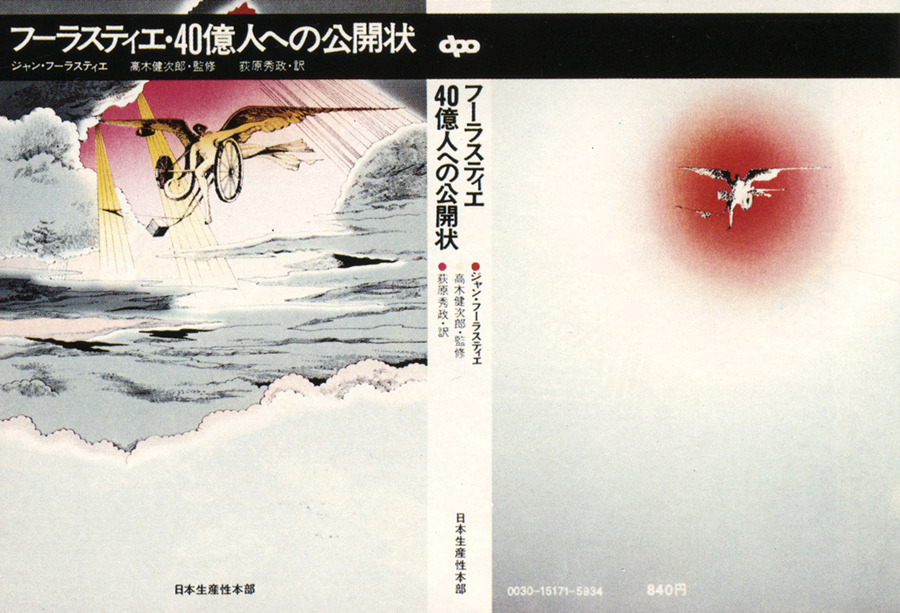 Hiroshi Manabe, early 70s
Hiroshi Manabe, early 70s
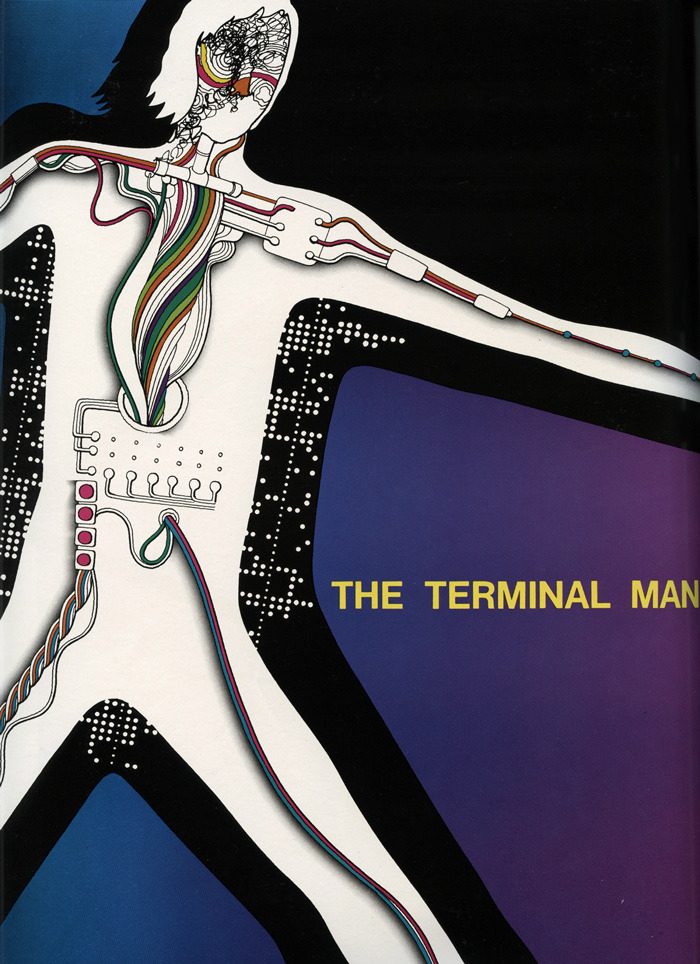 Hiroshi Manabe, early 70s
Hiroshi Manabe, early 70s
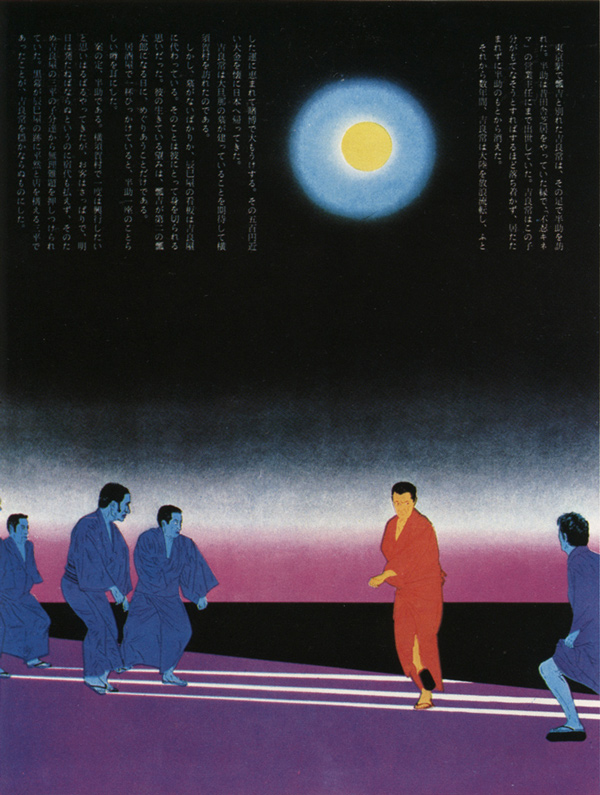 Tadanori Yokoo, early 70s
Tadanori Yokoo, early 70s
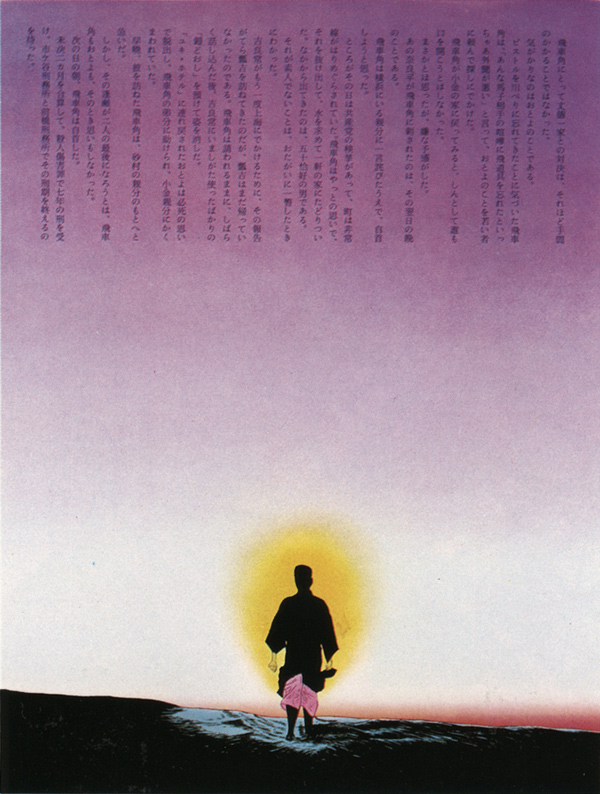 Tadanori Yokoo, early 70s
Tadanori Yokoo, early 70s
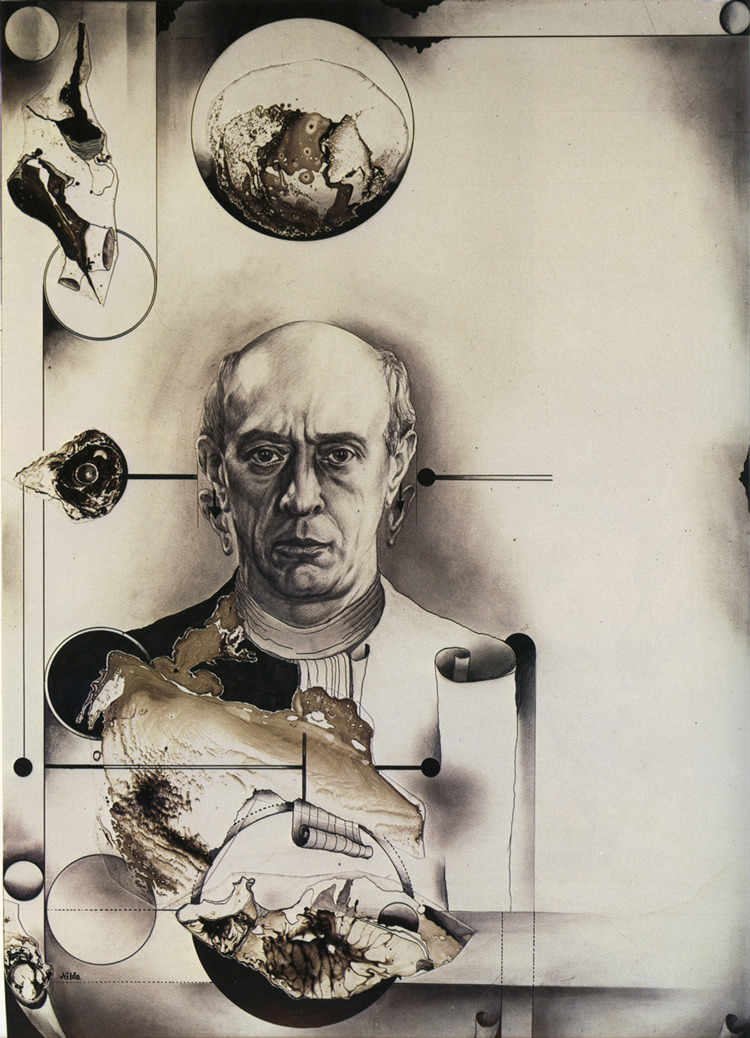 Ikuo Niida, early 70s
Ikuo Niida, early 70s
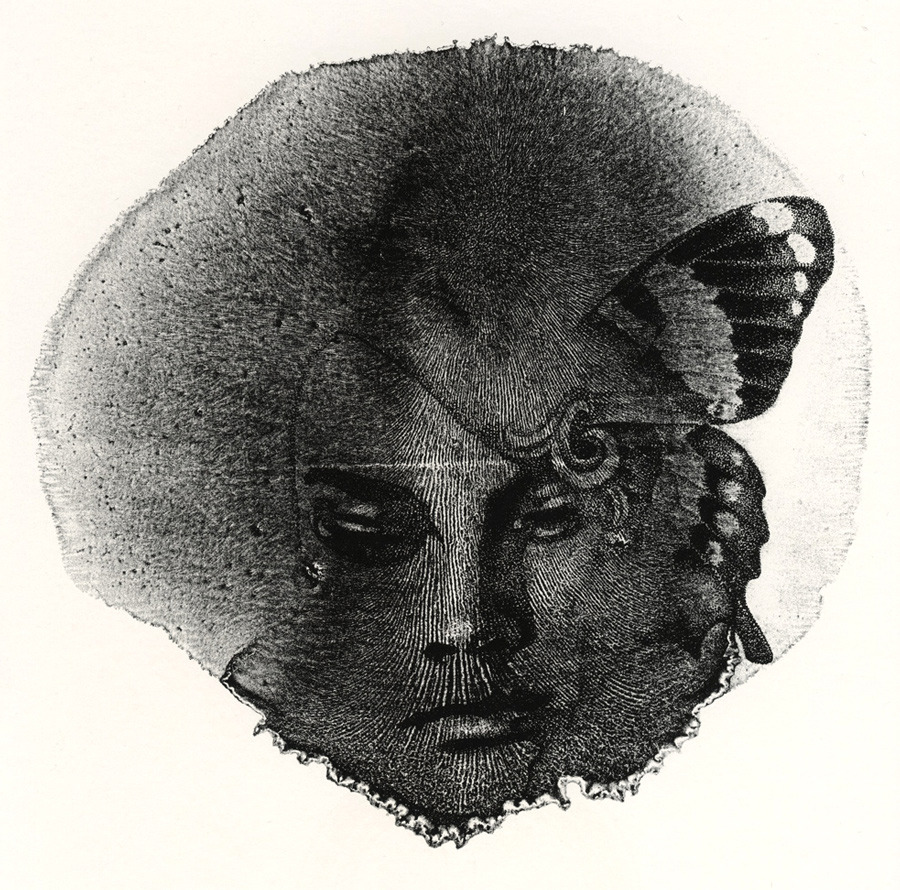 Kozo Mio, early 70s
Kozo Mio, early 70s
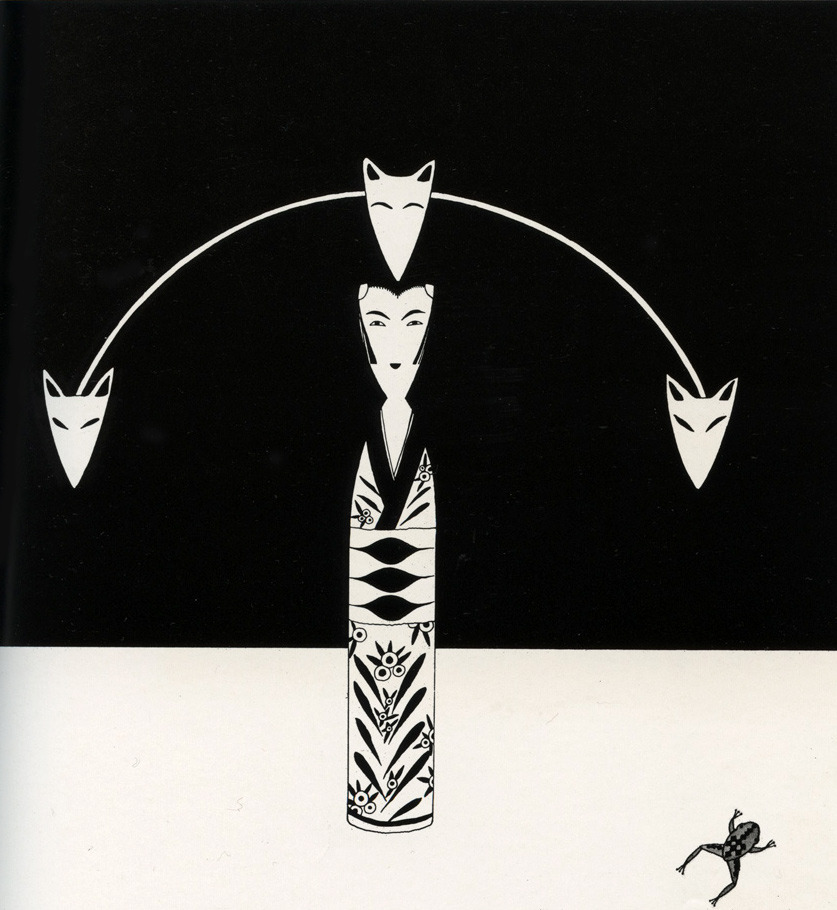 Yasuhiro Yomogida, early 70s
Yasuhiro Yomogida, early 70s
 Yoji Kuri, early 70s
Yoji Kuri, early 70s
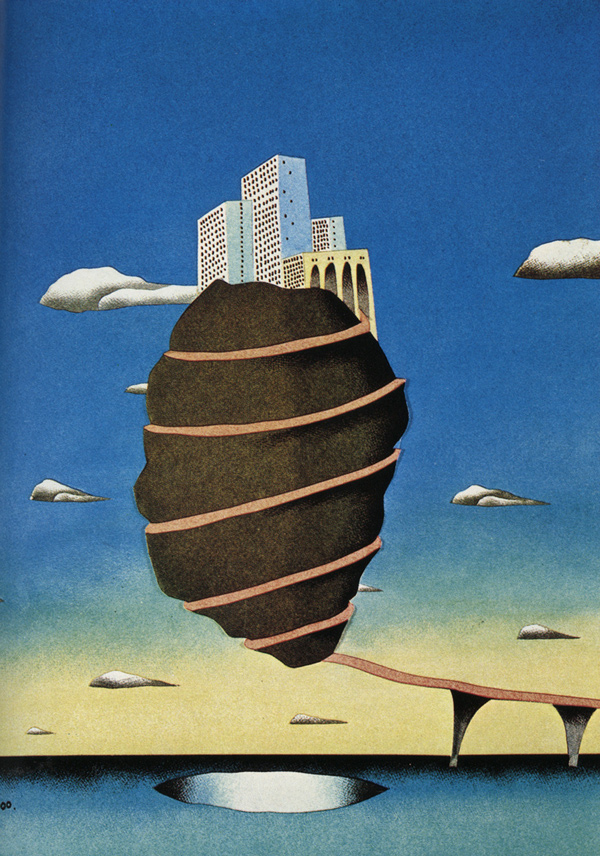 Yoji Kuri, early 70s
Yoji Kuri, early 70s
 Shusei Nagaoka, from Androla in Labyrinth, 1984
Shusei Nagaoka, from Androla in Labyrinth, 1984
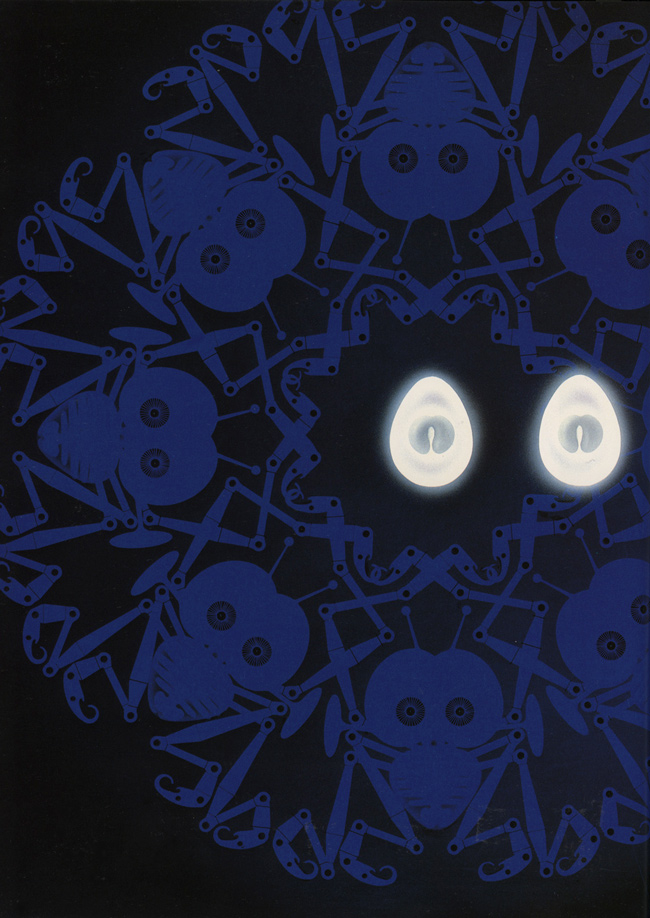 Shusei Nagaoka, from Androla in Labyrinth, 1984
Shusei Nagaoka, from Androla in Labyrinth, 1984
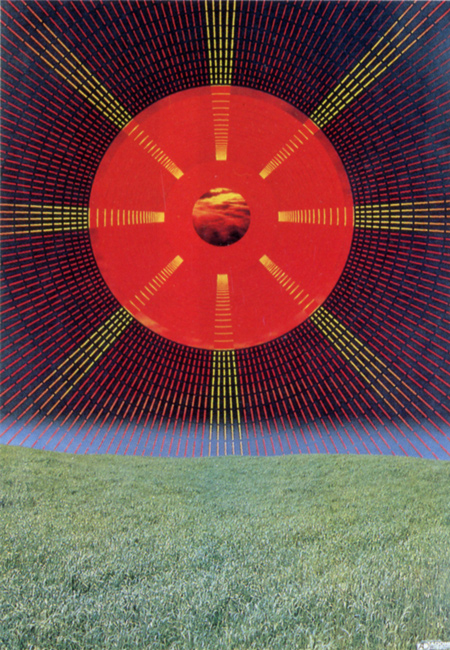 Kazumasa Nagai, poster
Kazumasa Nagai, poster
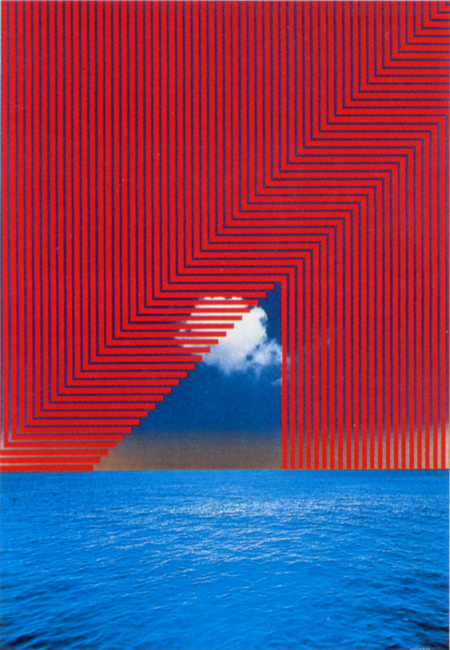 Kazumasa Nagai, poster
Kazumasa Nagai, poster
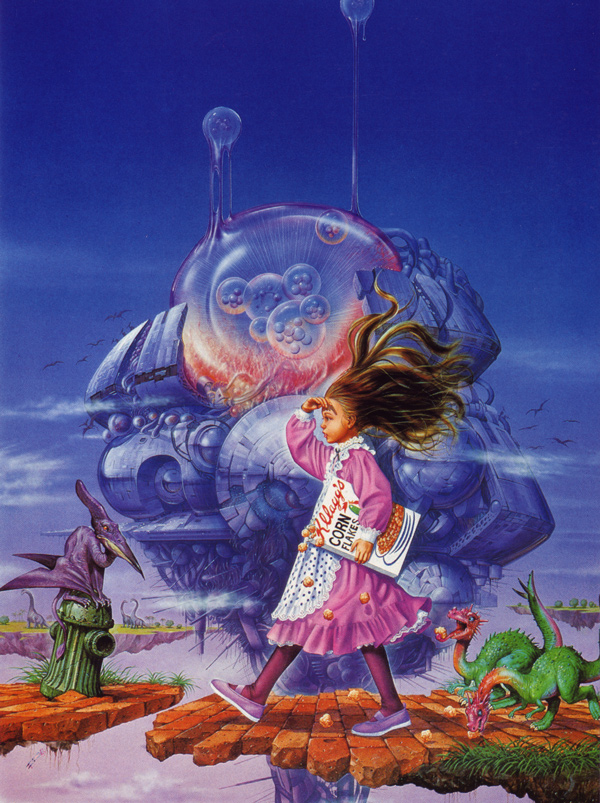 credit to come
credit to come
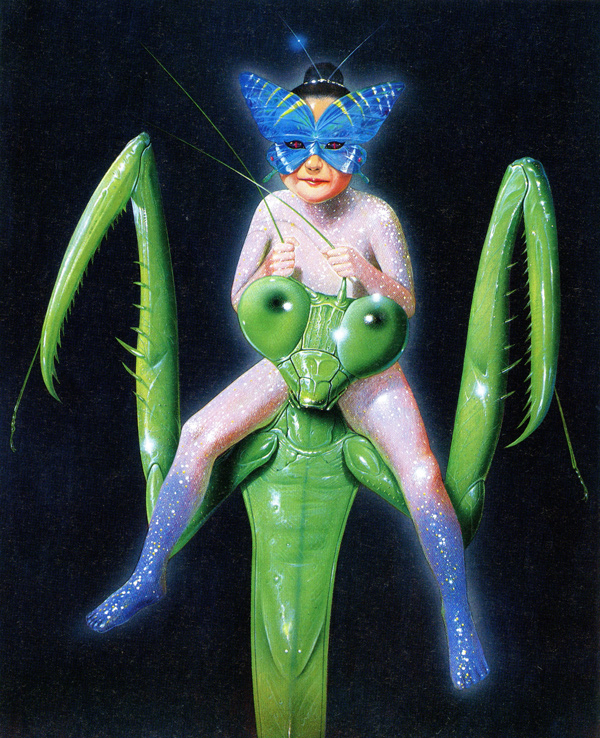 Natsuo Noma, late 80s
See the full series
Natsuo Noma, late 80s
See the full series
 Antioukhin
Antioukhin
 Helfenbein
Helfenbein
 Durand
Durand
 Oliete
Oliete
 unidentified artist
unidentified artist
 unidentified artist
unidentified artist
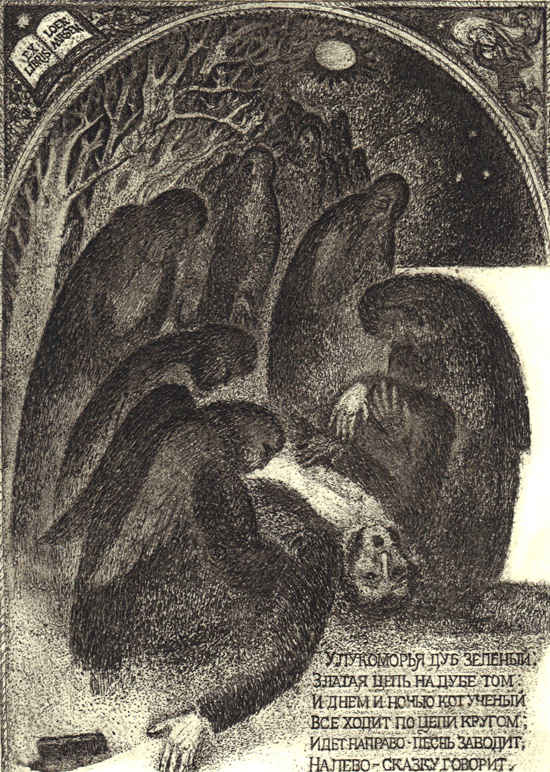 Vereschagin
Vereschagin
 Vadasz
Vadasz
 Kocak
Kocak
 Missieri
Missieri
 A bookplate by Richard Sica himself
See all bookplate posts on 50 Watts.
A bookplate by Richard Sica himself
See all bookplate posts on 50 Watts.
 ca. 1920s
ca. 1920s
 ca. 1920s
ca. 1920s
 1921–1922
1921–1922
 ca. 1920s
ca. 1920s
 1917–1918
1917–1918
 1923–1924
1923–1924
 1921
1921
 1918–1923
1918–1923
 1920–1923
1920–1923
 1919–1920
1919–1920
 1920
1920
 1918
1918
 1918–1920
1918–1920
 ca. 1920s
ca. 1920s
 ca. 1920s
ca. 1920s
 1922–23
1922–23
 ca. 1920s
ca. 1920s
 ca. 1920s
ca. 1920s
 1920–21
1920–21
 ca. 1920s
ca. 1920s
 1919–1920
I would have guessed late 1960s...
1919–1920
I would have guessed late 1960s...
 1920–21
See all posts featuring material from the Netherlands
1920–21
See all posts featuring material from the Netherlands



















 Bio from the Kodomo No Kuni site:Takei was born in Suwa, Nagano prefecture in 1894. After studying at the Hongo Yoga Kenkyujo (Hongo Research Institute for Western Art) he entered the Western-style art department of Tokyo Art School in 1919. He was an ardent admirer of illustrator Takehisa Yumeji and poet Kitahara Hakushu. After graduation from art school, he married in 1921 and to support his new family he began to produce illustrations for children for Kodomo no tomo [Child's Friend], a children's magazine published by Fujin no Tomo Sha. In 1922 he became one of the leading illustrators for Kodomo no kuni [Children's Land] from its inaugural issue. In 1923 he published Otogi no tamago [The Fairy's Egg], and in 1925 his first individual exhibition was held in Ginza in the heart of Tokyo. His Ramu-ramu O [King Ramu-ramu] came out in 1926. The following year, with Shimizu Yoshio, Okamoto Kiichi, Kawakami Shiro, and other illustrators contributing to the Kodomo no kuni, Takei formed the Nihon Doga Kyokai (Japan Association of Illustration for Children), as part of the effort to achieve artistic quality in illustrations for children. Following Okamoto's death, Takei succeeded him as critic and selector of illustrations submitted to Kodomo no kuni in 1931. In 1955, he became editorial adviser for the magazine Kinda bukku [Kinder Book].
I again found these images in the database of the National Diet Library.
Some of Takei's books have been reprinted and are available from amazon.co.jp.
Previous posts on this artist
Bio from the Kodomo No Kuni site:Takei was born in Suwa, Nagano prefecture in 1894. After studying at the Hongo Yoga Kenkyujo (Hongo Research Institute for Western Art) he entered the Western-style art department of Tokyo Art School in 1919. He was an ardent admirer of illustrator Takehisa Yumeji and poet Kitahara Hakushu. After graduation from art school, he married in 1921 and to support his new family he began to produce illustrations for children for Kodomo no tomo [Child's Friend], a children's magazine published by Fujin no Tomo Sha. In 1922 he became one of the leading illustrators for Kodomo no kuni [Children's Land] from its inaugural issue. In 1923 he published Otogi no tamago [The Fairy's Egg], and in 1925 his first individual exhibition was held in Ginza in the heart of Tokyo. His Ramu-ramu O [King Ramu-ramu] came out in 1926. The following year, with Shimizu Yoshio, Okamoto Kiichi, Kawakami Shiro, and other illustrators contributing to the Kodomo no kuni, Takei formed the Nihon Doga Kyokai (Japan Association of Illustration for Children), as part of the effort to achieve artistic quality in illustrations for children. Following Okamoto's death, Takei succeeded him as critic and selector of illustrations submitted to Kodomo no kuni in 1931. In 1955, he became editorial adviser for the magazine Kinda bukku [Kinder Book].
I again found these images in the database of the National Diet Library.
Some of Takei's books have been reprinted and are available from amazon.co.jp.
Previous posts on this artist



































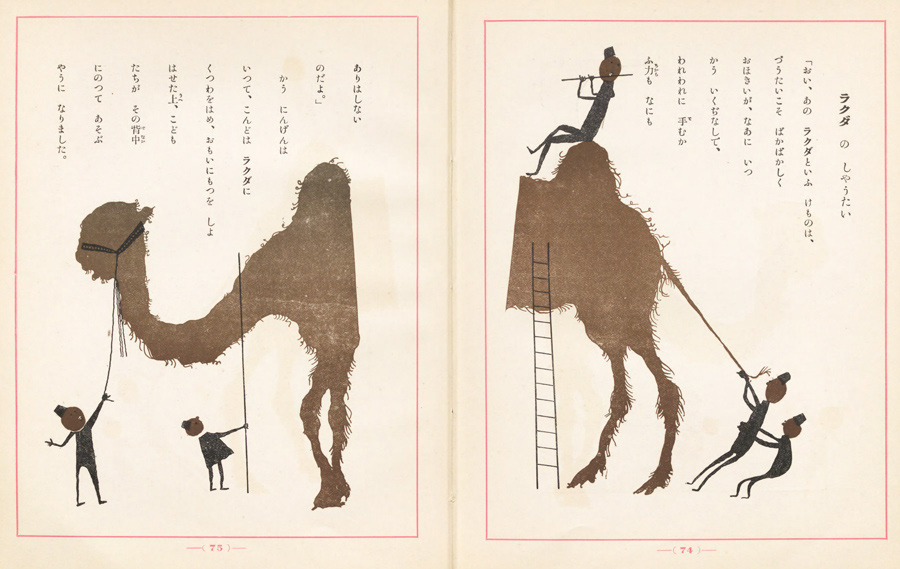 Previous posts on this artist
Previous posts on this artist





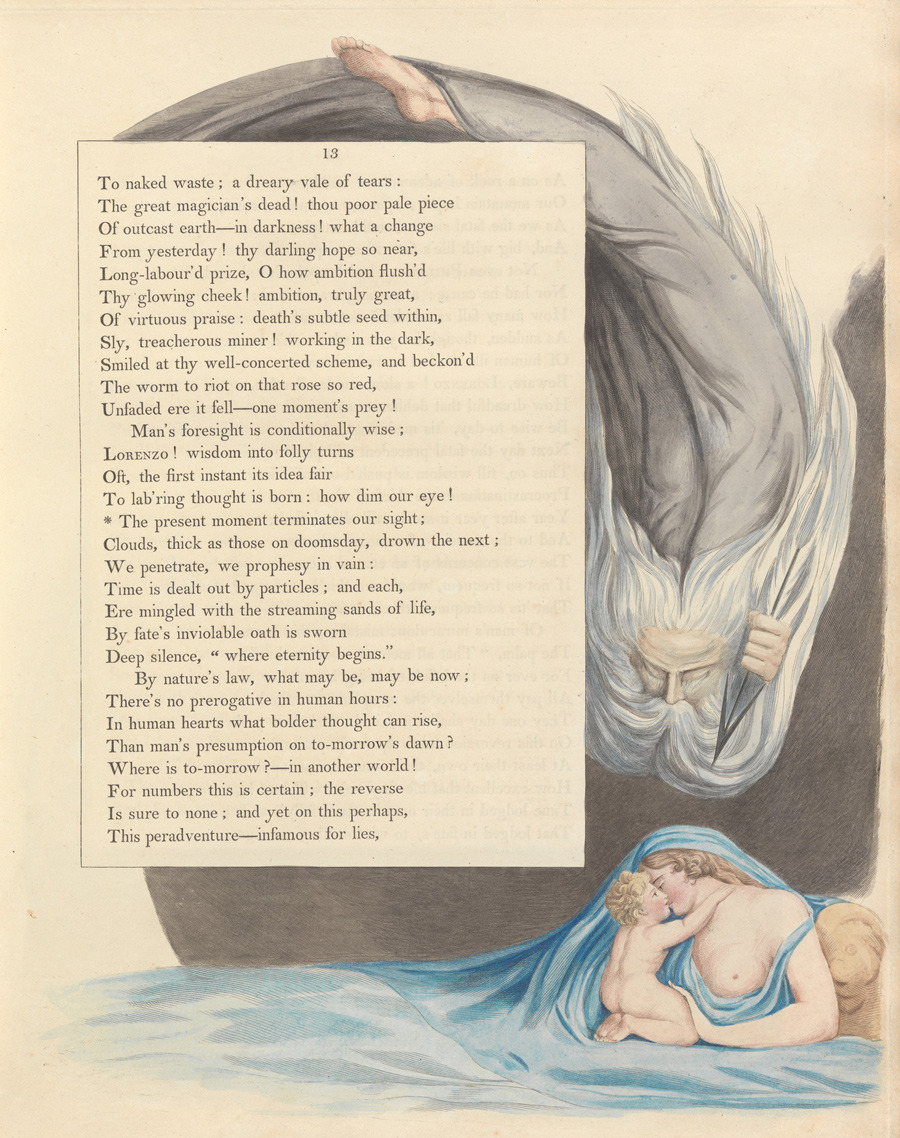



















 "Pyrosoma and Diver"
Reading like something from a Gustav Meyrink novel:"Professor Moseley captured a Pyrosoma four feet long, ten inches in diameter, with walls an inch in thickness. It was placed upon the deck of the vessel, and, when the naturalist wrote his name upon the animal with his finger, it came out in letters of fire: each letter seeming to increase in size, until the entire name was lost in a blaze of light that radiated rapidly and soon suffused the entire animal, presenting a marvellous spectacle and showing, in a striking manner, how intimately the animals are connected."
"Pyrosoma and Diver"
Reading like something from a Gustav Meyrink novel:"Professor Moseley captured a Pyrosoma four feet long, ten inches in diameter, with walls an inch in thickness. It was placed upon the deck of the vessel, and, when the naturalist wrote his name upon the animal with his finger, it came out in letters of fire: each letter seeming to increase in size, until the entire name was lost in a blaze of light that radiated rapidly and soon suffused the entire animal, presenting a marvellous spectacle and showing, in a striking manner, how intimately the animals are connected."
 "Sea Bottom"
"Sea Bottom"
 "Luminous Protozoans"
"Luminous Protozoans"
 "Luminous Insect / Luminous Mushrooms"
"Luminous Insect / Luminous Mushrooms"
 "Chiasmodus / Sun-Fish / Plagiodus / Harpodon / Beryx"
"Chiasmodus / Sun-Fish / Plagiodus / Harpodon / Beryx"
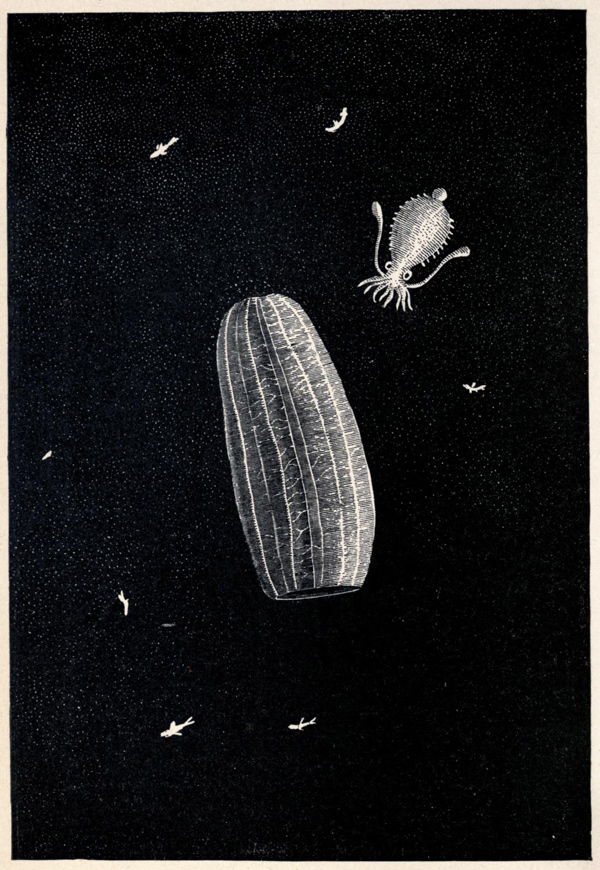 "Luminous Sea-Jelly and Mollusk"
"Luminous Sea-Jelly and Mollusk"
 "Venus' Girdle"
"Venus' Girdle"
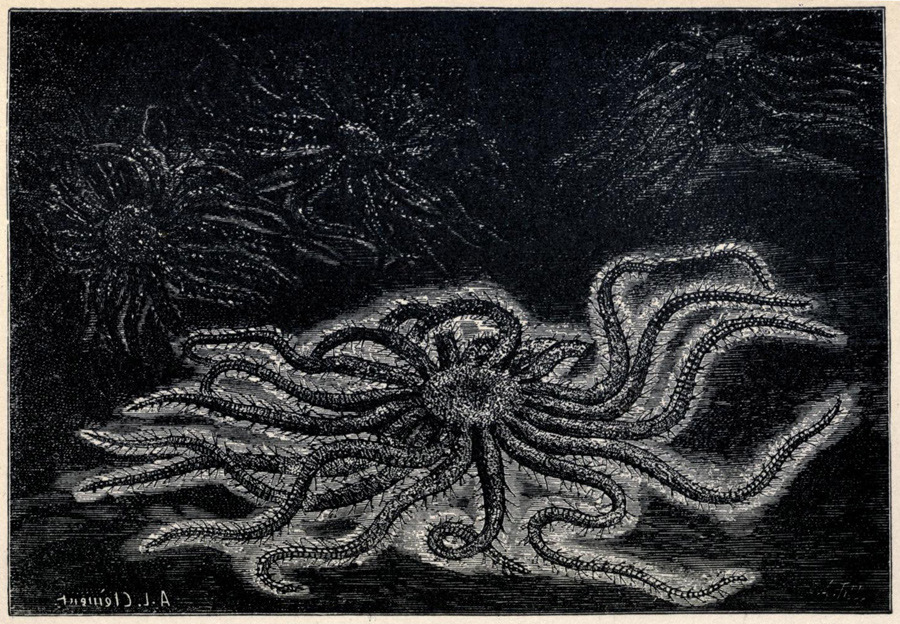 "Luminous Star Fishes"
"Luminous Star Fishes"
 "Burrow of Pholas / Sea Pen"
"Burrow of Pholas / Sea Pen"
 "Apolemia / Cleodora / Praya"
"Apolemia / Cleodora / Praya"
 "Luminous Beetle (In burrow of Mole Cricket)"
"Luminous Beetle (In burrow of Mole Cricket)"
 "Spider Crab"
"Spider Crab"
 "Luminous Crustaceans"
"Luminous Crustaceans"
 "Luminous Umbellularia / Luminous Fish / Silicious Sponge / Luminous Crustacean / Luminous Corals"
"Luminous Umbellularia / Luminous Fish / Silicious Sponge / Luminous Crustacean / Luminous Corals"
 "Luminous Fish. With two luminous disks, one emitting a golden, the other a greenish light."
"Luminous Fish. With two luminous disks, one emitting a golden, the other a greenish light."
 "Pelican Fish"
"Pelican Fish"
 "Luminous Beetles, etc." [a loaded "et cetera"]
From the facing page (reminding me of the hats of the poet-general's mossy troops in The Baron in the Trees):
"Gen. Count Dejean, aide-de-camp to Napolean, was a most enthusiastic collector of beetles; and it is even said of him that he would march his army out of its way to pass through a good collecting locality. At all times during the campaigns which he helped to render famous, his attention was not taken from his favorite occupation; and his military cap was invariably conspicuous from the gorgeous beetles that were there immolated. Every one in the army, from the emperor down to his men, was aware of what was termed his weakness; and the latter were constantly on the lookout for specimens for their commander. At the battle of Wagram, 1809, the general went into the combat with his hat as usual ornamented with beetles, which he had received that morning; and, while standing near the emperor, a shot from the enemy struck him upon the head, knocking him senseless, and destroying his collection, -- the hat being completely torn to pieces. The emperor, thinking him fatally wounded, hastened to his side, asking if he was still alive; upon which the general gasped out, "I am not dead; but, alas, my insects are all gone!"
"Luminous Beetles, etc." [a loaded "et cetera"]
From the facing page (reminding me of the hats of the poet-general's mossy troops in The Baron in the Trees):
"Gen. Count Dejean, aide-de-camp to Napolean, was a most enthusiastic collector of beetles; and it is even said of him that he would march his army out of its way to pass through a good collecting locality. At all times during the campaigns which he helped to render famous, his attention was not taken from his favorite occupation; and his military cap was invariably conspicuous from the gorgeous beetles that were there immolated. Every one in the army, from the emperor down to his men, was aware of what was termed his weakness; and the latter were constantly on the lookout for specimens for their commander. At the battle of Wagram, 1809, the general went into the combat with his hat as usual ornamented with beetles, which he had received that morning; and, while standing near the emperor, a shot from the enemy struck him upon the head, knocking him senseless, and destroying his collection, -- the hat being completely torn to pieces. The emperor, thinking him fatally wounded, hastened to his side, asking if he was still alive; upon which the general gasped out, "I am not dead; but, alas, my insects are all gone!"
 1954
Seven scans come from the book 1950: Japanese Graphic Design in the '50s: The Designer Is Born (possibly still available from Amazon Japan, ISBN 9784336050755). The rest come from the great Japanese blog Retromaniagogo and its previous incarnation That's Eurobeat (source for my first post). The blogger has been scanning vintage magazine ads since August 2007 (the same month I started "A Journey Round My Skull") and he occasionally highlights illustrations too. He's well on his way to 10,000 scans.
1954
Seven scans come from the book 1950: Japanese Graphic Design in the '50s: The Designer Is Born (possibly still available from Amazon Japan, ISBN 9784336050755). The rest come from the great Japanese blog Retromaniagogo and its previous incarnation That's Eurobeat (source for my first post). The blogger has been scanning vintage magazine ads since August 2007 (the same month I started "A Journey Round My Skull") and he occasionally highlights illustrations too. He's well on his way to 10,000 scans.
 1954
1954
 1951
1951
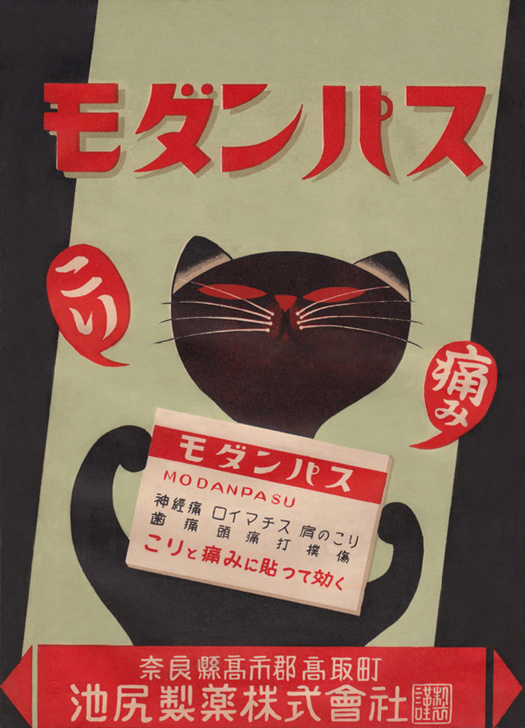 1954
1954
 1955
1955
 1957
1957
 1957
1957
 1952
1952
 1953, Toyo Rayon ad by Ryuichi Yamashiro
1953, Toyo Rayon ad by Ryuichi Yamashiro
 1956
1956
 1957
1957
 1951
1951
 1954, designed by Tadashi Ohashi
These two are probably magazine covers
1954, designed by Tadashi Ohashi
These two are probably magazine covers
 1955, designed by Tadashi Ohashi
1955, designed by Tadashi Ohashi
 1954
1954
 1954
1954
 1957
1957
 1950
1950
 1958
1958
 1957
1957
 1956
Previously: a post of 1950s ads from the same resource
See all posts tagged Japan on 50 Watts
1956
Previously: a post of 1950s ads from the same resource
See all posts tagged Japan on 50 Watts
 Previous post on Mérida (1891–1984): The Hungry Moon
About the artist (from the back flap)Carlos Merida, born in Guatemala, went to Paris at 19. He studied art there for five years, took a brief trip through the United States, and then returned to Guatemala. Five years later he moved to Mexico, where he now lives.
Mr. Merida has always been closely connected with the native art, both modern and traditional, of the two countries in which he has lived. He has worked with the famous mural painters Rivera and Orozco, has done settings for the Mexican theater, and is now working with a Mexican ballet group, on costumes, sets, and choreography. He has done colorfully illustrated books on the folk arts of Mexico and Guatemala and has recently taken great interest in the illustration of children's books.
Carlos Merida's versatility and success have brought him wide recognition. His paintings are exhibited in important art centers all through the United States and Mexico.
Previous post on Mérida (1891–1984): The Hungry Moon
About the artist (from the back flap)Carlos Merida, born in Guatemala, went to Paris at 19. He studied art there for five years, took a brief trip through the United States, and then returned to Guatemala. Five years later he moved to Mexico, where he now lives.
Mr. Merida has always been closely connected with the native art, both modern and traditional, of the two countries in which he has lived. He has worked with the famous mural painters Rivera and Orozco, has done settings for the Mexican theater, and is now working with a Mexican ballet group, on costumes, sets, and choreography. He has done colorfully illustrated books on the folk arts of Mexico and Guatemala and has recently taken great interest in the illustration of children's books.
Carlos Merida's versatility and success have brought him wide recognition. His paintings are exhibited in important art centers all through the United States and Mexico.
 endpapers
endpapers


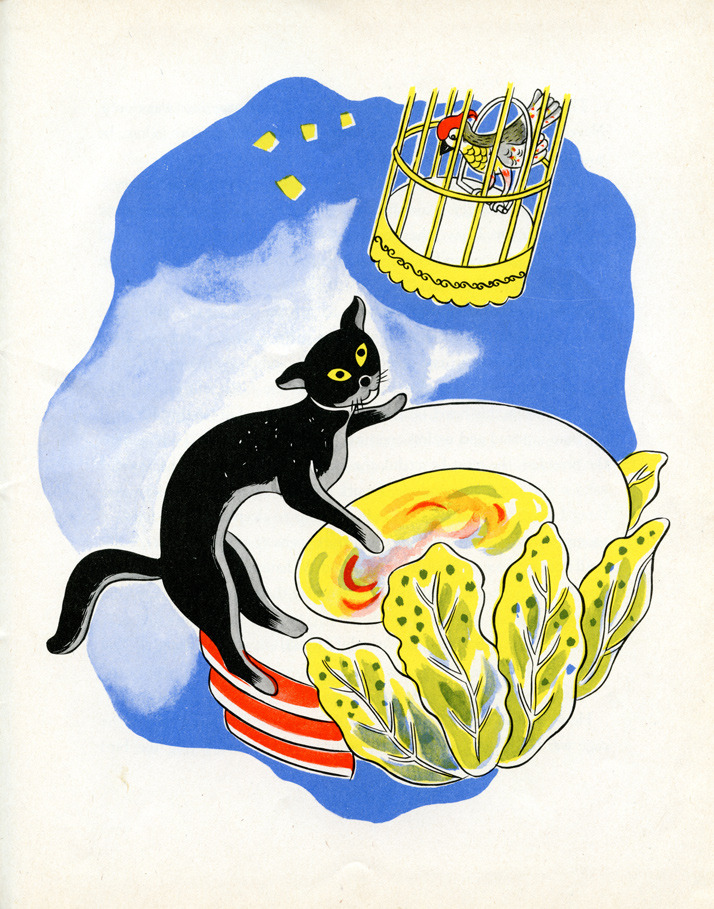
 And though one of my friends dislikes it when I post details of images...
And though one of my friends dislikes it when I post details of images...




 Previously: The Hungry Moon
Previously: The Hungry Moon












 update: Chris at Dreamers Rise pointed out that H. L. Stephens [Cock Robin!] illustrated an edition around the same time. See it here (superior duck swallowing image below):
update: Chris at Dreamers Rise pointed out that H. L. Stephens [Cock Robin!] illustrated an edition around the same time. See it here (superior duck swallowing image below):

 I assume this is an adaptation of bits of the Chinese epic Journey to the West.
The scans come from the database of the National Diet Library. I've previously featured this illustrator's Koganemaru the Dog.
Bio for Shotaro Honda (1893–1939) via Kodomo no kuni:Honda was born in Hamamatsu, Shizuoka prefecture in 1893. In 1907, at the age of fourteen, he was accepted at the Taiheiyo Gakai Kenkyujo, a school of Western-style art affiliated with the Taiheiyo Gakai (Pacific Art Society Institute) established in 1904. He studied Western-style painting under Ishii Hakutei and Ishii Toraji. At the same time, he taught himself ukiyo-e by copying works by the masters. In 1910, he won first place in a cover design contest for the magazine Shonen sekai [Boy's World]. In 1913, he started illustrating for magazines published by Hakubunkan, including Yonen gaho [Toddler's Illustrated] and Yonen sekai [Infant's World], and for the magazine Shojo [Girls] printed by Jijishinpo. In the 1920s, he was active as an established illustrator for such prominent journals as Kodomo no kuni [Children's Land], Kodomo asahi [Children's Asahi], and Kodomo no tomo [The Child's Friend]. From 1928 to 1936 he illustrated for Shonen kurabu [Boy's Club]. He was also one of the artists recruited to illustrate the well-known Nihon dowa senshu [Collected Japanese Stories] (Maruzen Co., 1926-1936) and Nihon jido bunko [Library for Japanese Children] (Arusu, 1927-1930). Among Honda's leading works are Koganemaru [Koganemaru the Dog] by Iwaya Sazanami (1938), Songoku [The Monkey King] (1939), and Songoku to Hakkai [The Monkey King and Hakkai] (1940) in the Kodansha Picture Book series.
I assume this is an adaptation of bits of the Chinese epic Journey to the West.
The scans come from the database of the National Diet Library. I've previously featured this illustrator's Koganemaru the Dog.
Bio for Shotaro Honda (1893–1939) via Kodomo no kuni:Honda was born in Hamamatsu, Shizuoka prefecture in 1893. In 1907, at the age of fourteen, he was accepted at the Taiheiyo Gakai Kenkyujo, a school of Western-style art affiliated with the Taiheiyo Gakai (Pacific Art Society Institute) established in 1904. He studied Western-style painting under Ishii Hakutei and Ishii Toraji. At the same time, he taught himself ukiyo-e by copying works by the masters. In 1910, he won first place in a cover design contest for the magazine Shonen sekai [Boy's World]. In 1913, he started illustrating for magazines published by Hakubunkan, including Yonen gaho [Toddler's Illustrated] and Yonen sekai [Infant's World], and for the magazine Shojo [Girls] printed by Jijishinpo. In the 1920s, he was active as an established illustrator for such prominent journals as Kodomo no kuni [Children's Land], Kodomo asahi [Children's Asahi], and Kodomo no tomo [The Child's Friend]. From 1928 to 1936 he illustrated for Shonen kurabu [Boy's Club]. He was also one of the artists recruited to illustrate the well-known Nihon dowa senshu [Collected Japanese Stories] (Maruzen Co., 1926-1936) and Nihon jido bunko [Library for Japanese Children] (Arusu, 1927-1930). Among Honda's leading works are Koganemaru [Koganemaru the Dog] by Iwaya Sazanami (1938), Songoku [The Monkey King] (1939), and Songoku to Hakkai [The Monkey King and Hakkai] (1940) in the Kodansha Picture Book series.










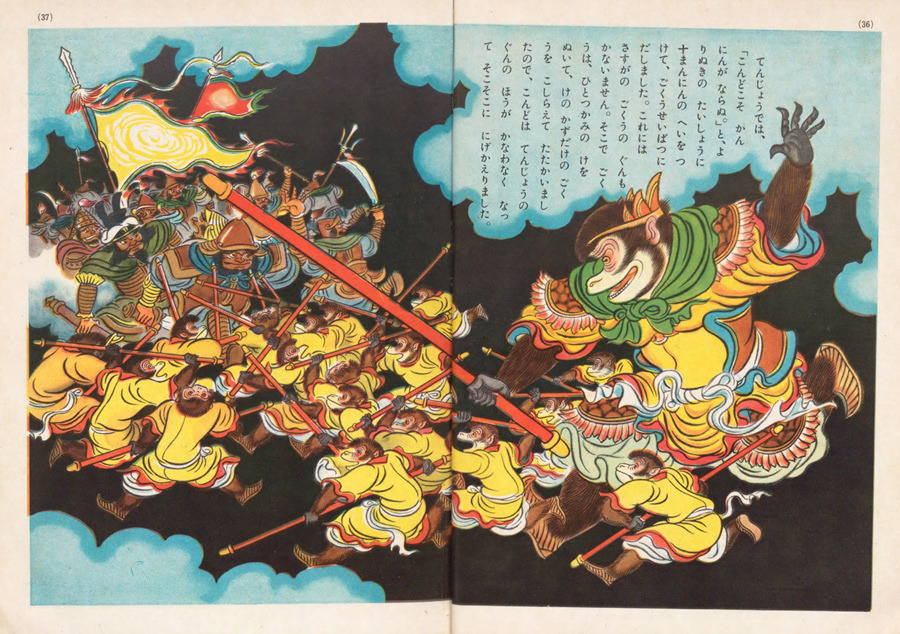





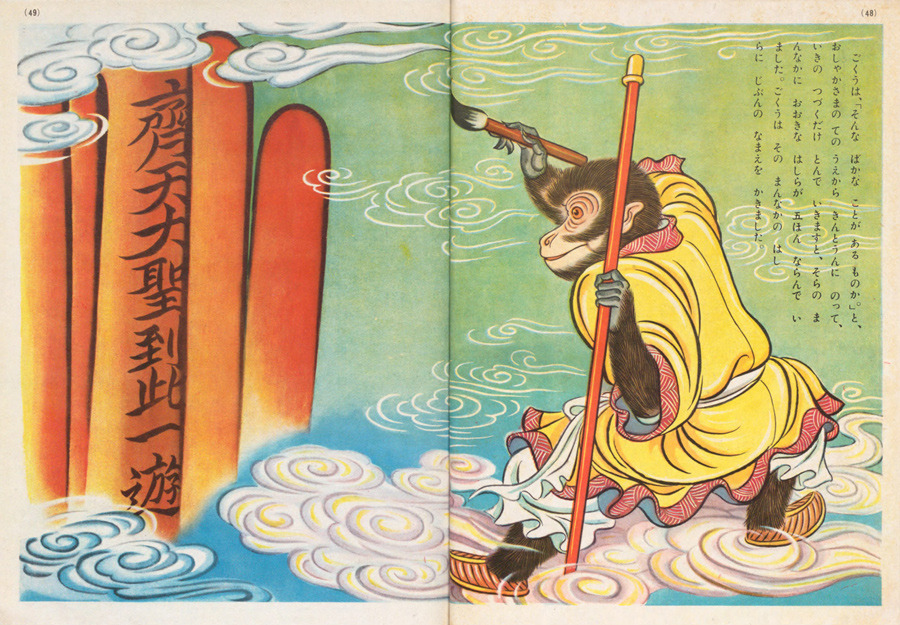



 Previous posts tagged "Japan"
Previous posts tagged "Japan"
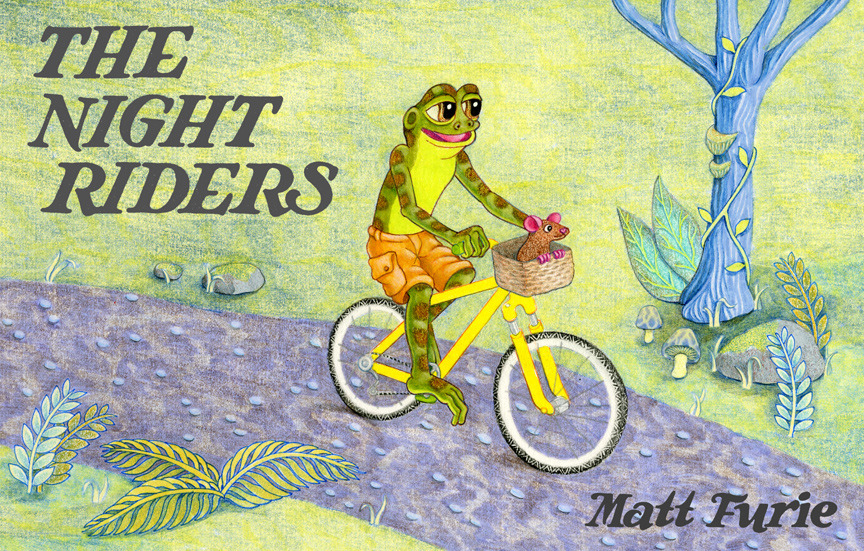 As a frequent visitor of 50 Watts might imagine just by looking at the cover, The Night Riders is my favorite book of the year. It will soon enough be referred to as a classic and I hope it spawns many sequels.
With his new imprint, Brian McMullen picks up where the legendary Harlin Quist left off, and I can't wait to see what he dreams up next. Launched just last year, the McMullens imprint joins Enchanted Lion in what feels like a renaissance in visionary independent children's book publishing.
Buy The Night Riders from the publisher, Amazon, or fine bookstores everywhere. Better yet just buy a subscription to the McMullens series.
Here are some pages with my commentary to help locate you in the story.
As a frequent visitor of 50 Watts might imagine just by looking at the cover, The Night Riders is my favorite book of the year. It will soon enough be referred to as a classic and I hope it spawns many sequels.
With his new imprint, Brian McMullen picks up where the legendary Harlin Quist left off, and I can't wait to see what he dreams up next. Launched just last year, the McMullens imprint joins Enchanted Lion in what feels like a renaissance in visionary independent children's book publishing.
Buy The Night Riders from the publisher, Amazon, or fine bookstores everywhere. Better yet just buy a subscription to the McMullens series.
Here are some pages with my commentary to help locate you in the story.
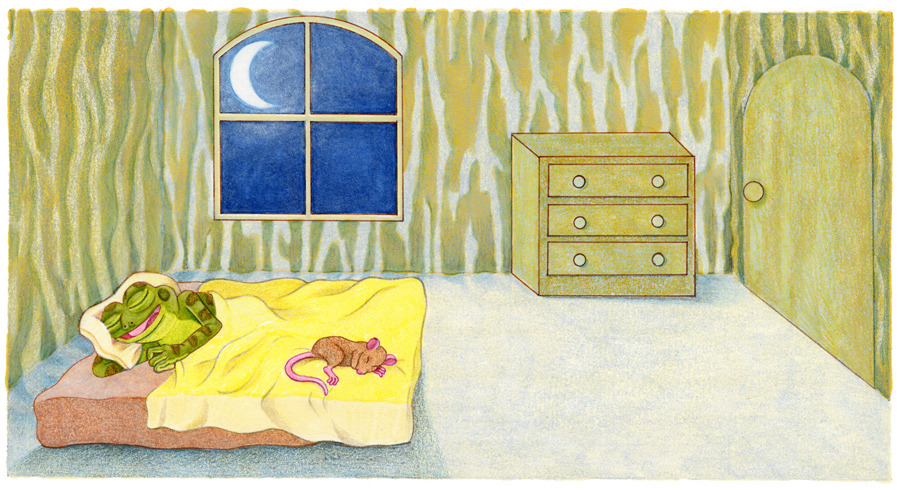 [Our night riders, a frog and a rat, wake up for a late night snack and bike ride — or maybe, as I like to think, they're dreaming.]
[Our night riders, a frog and a rat, wake up for a late night snack and bike ride — or maybe, as I like to think, they're dreaming.]

 [Fetching the bike from their mushroom garage, they set off for their adventure.]
[Fetching the bike from their mushroom garage, they set off for their adventure.]


 [They meet a dragon who turns out to be very friendly.]
[They meet a dragon who turns out to be very friendly.]

 [The dragon introduces them to his subterranean friend...]
[The dragon introduces them to his subterranean friend...]
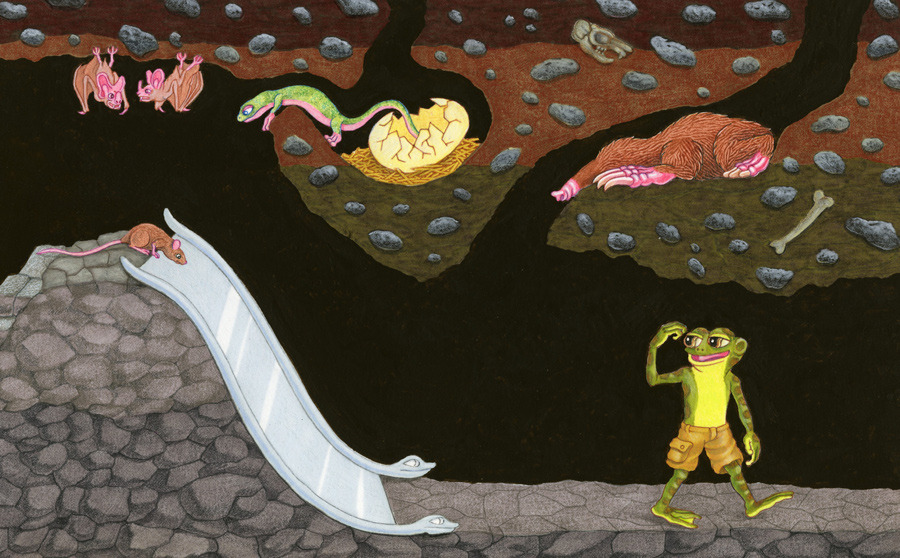 [...a jean-short-wearing gamer bat.]
[...a jean-short-wearing gamer bat.]
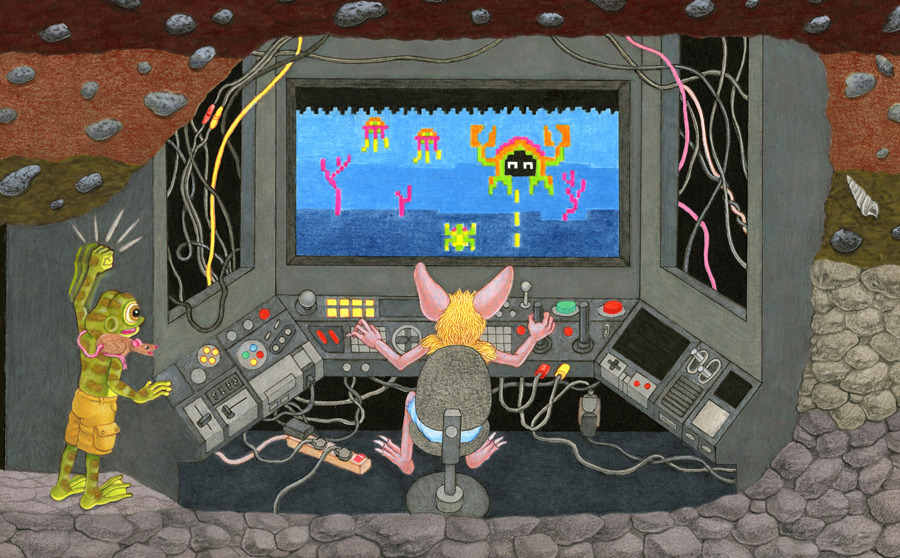
 [Together they visit a deserted seaside compound with lots of fountains.]
[Together they visit a deserted seaside compound with lots of fountains.]
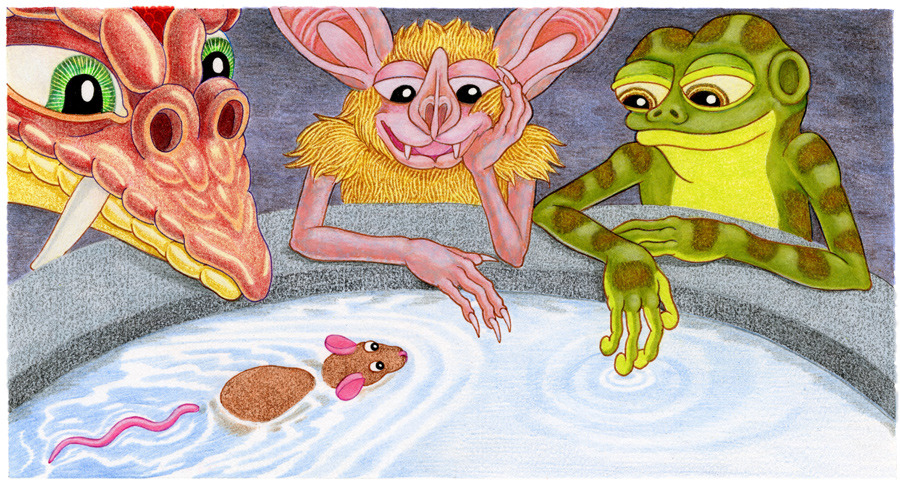
 [They soon decide to take a dip in the ocean.]
[They soon decide to take a dip in the ocean.]
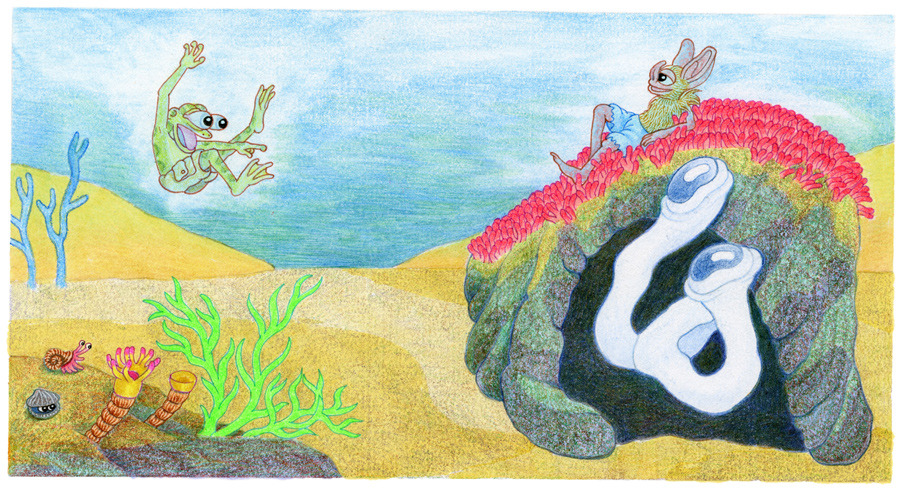
 [Purple dolphins save them from a scary crab.]
[Purple dolphins save them from a scary crab.]


 [And they watch the sun rise.]
[And they watch the sun rise.]
 Like all McMullens, the book's cover folds out into a huge 2-sided poster:
Like all McMullens, the book's cover folds out into a huge 2-sided poster:
 detail from fold-out front cover
detail from fold-out front cover
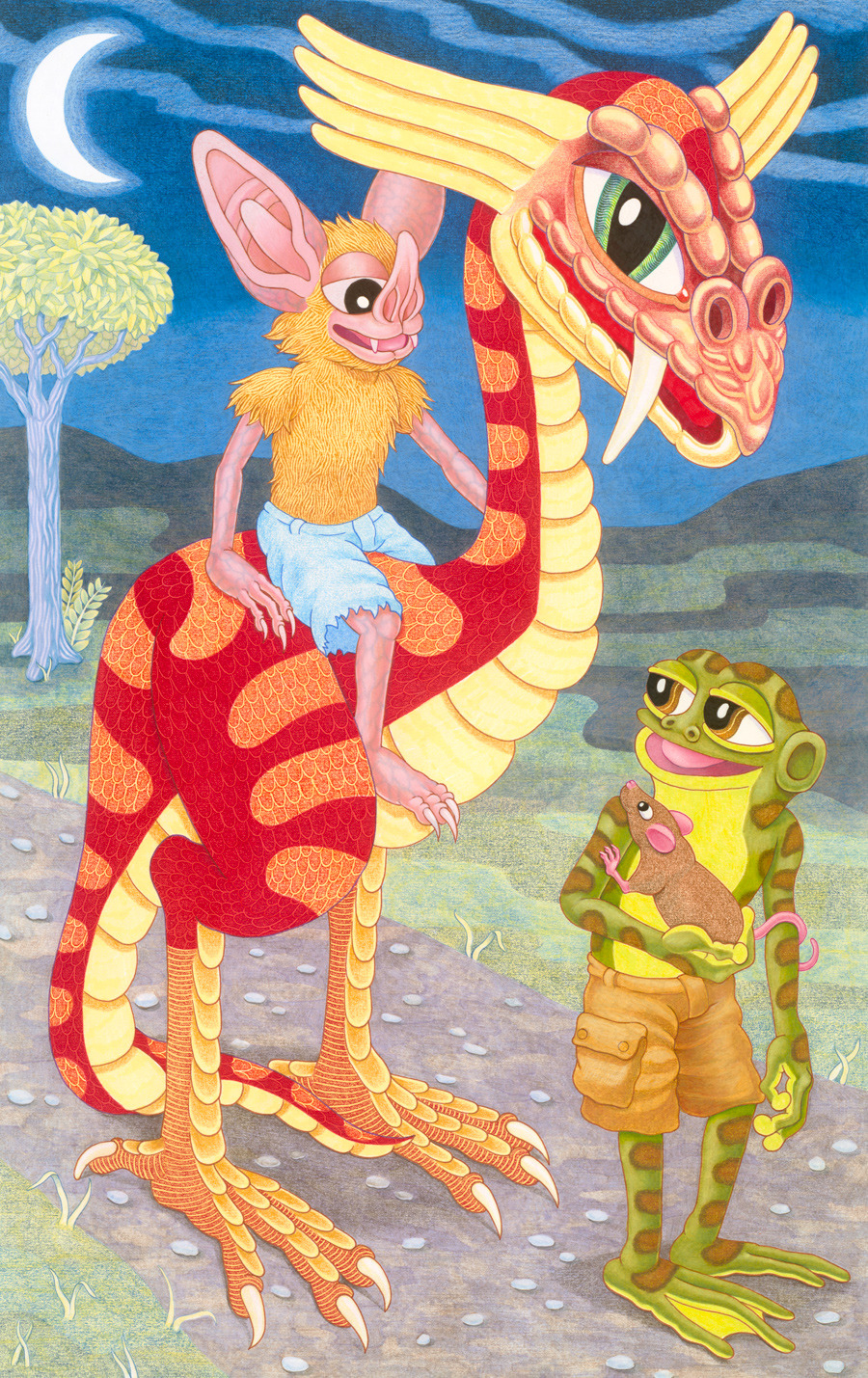 other side of fold-out poster, made much smaller than actual size
other side of fold-out poster, made much smaller than actual size




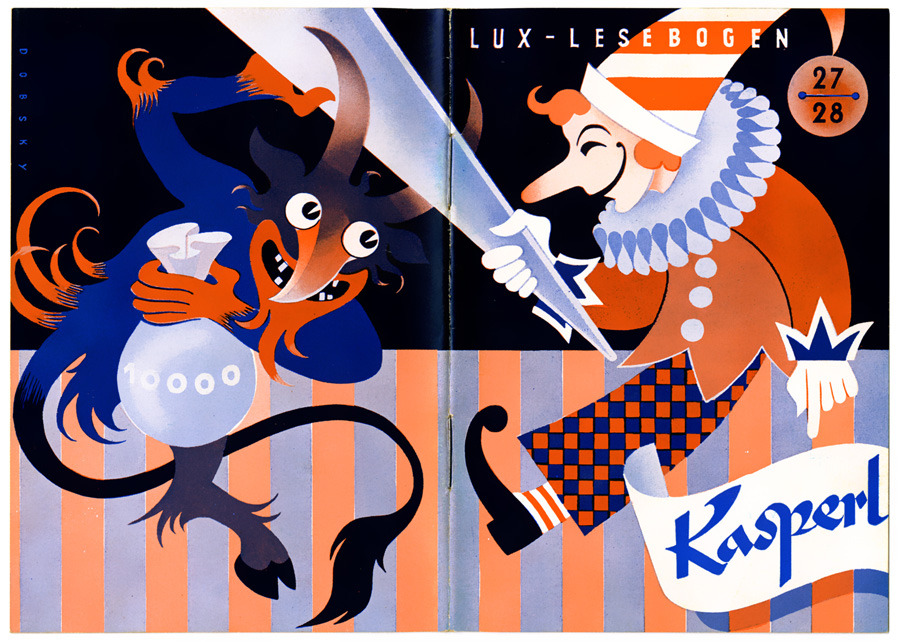















 Two blown-up images:
Two blown-up images:









